Leadership & Management : Diploma in Business
VerifiedAdded on 2022/01/18
|29
|8524
|28
AI Summary
Contribute Materials
Your contribution can guide someone’s learning journey. Share your
documents today.
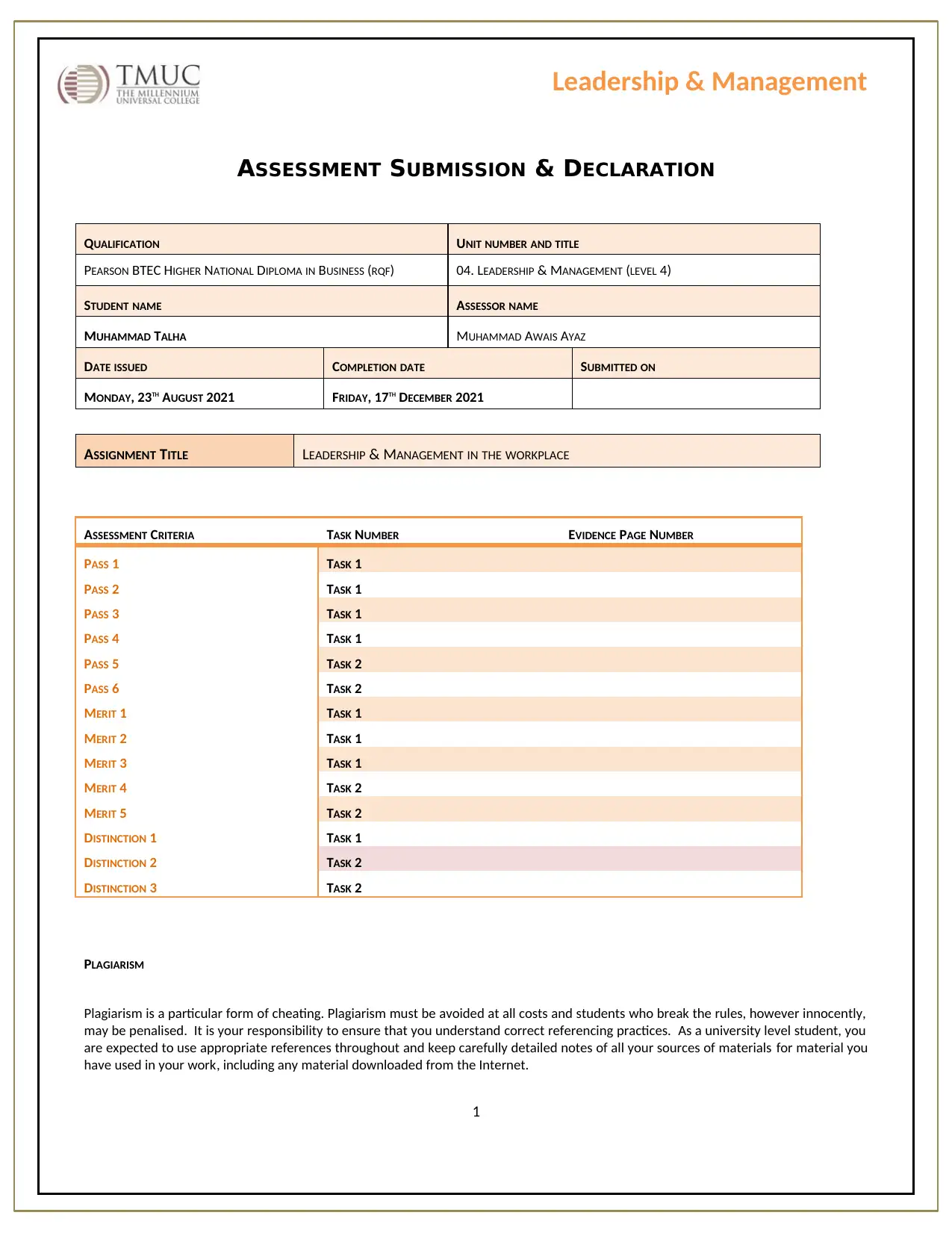
Leadership & Management
ASSESSMENT SUBMISSION & DECLARATION
QUALIFICATION UNIT NUMBER AND TITLE
PEARSON BTEC HIGHER NATIONAL DIPLOMA IN BUSINESS (RQF) 04. LEADERSHIP & MANAGEMENT (LEVEL 4)
STUDENT NAME ASSESSOR NAME
MUHAMMAD TALHA MUHAMMAD AWAIS AYAZ
DATE ISSUED COMPLETION DATE SUBMITTED ON
MONDAY, 23TH AUGUST 2021 FRIDAY, 17TH DECEMBER 2021
ASSIGNMENT TITLE LEADERSHIP & MANAGEMENT IN THE WORKPLACE
ASSESSMENT CRITERIA TASK NUMBER EVIDENCE PAGE NUMBER
PASS 1 TASK 1
PASS 2 TASK 1
PASS 3 TASK 1
PASS 4 TASK 1
PASS 5 TASK 2
PASS 6 TASK 2
MERIT 1 TASK 1
MERIT 2 TASK 1
MERIT 3 TASK 1
MERIT 4 TASK 2
MERIT 5 TASK 2
DISTINCTION 1 TASK 1
DISTINCTION 2 TASK 2
DISTINCTION 3 TASK 2
PLAGIARISM
Plagiarism is a particular form of cheating. Plagiarism must be avoided at all costs and students who break the rules, however innocently,
may be penalised. It is your responsibility to ensure that you understand correct referencing practices. As a university level student, you
are expected to use appropriate references throughout and keep carefully detailed notes of all your sources of materials for material you
have used in your work, including any material downloaded from the Internet.
1
ASSESSMENT SUBMISSION & DECLARATION
QUALIFICATION UNIT NUMBER AND TITLE
PEARSON BTEC HIGHER NATIONAL DIPLOMA IN BUSINESS (RQF) 04. LEADERSHIP & MANAGEMENT (LEVEL 4)
STUDENT NAME ASSESSOR NAME
MUHAMMAD TALHA MUHAMMAD AWAIS AYAZ
DATE ISSUED COMPLETION DATE SUBMITTED ON
MONDAY, 23TH AUGUST 2021 FRIDAY, 17TH DECEMBER 2021
ASSIGNMENT TITLE LEADERSHIP & MANAGEMENT IN THE WORKPLACE
ASSESSMENT CRITERIA TASK NUMBER EVIDENCE PAGE NUMBER
PASS 1 TASK 1
PASS 2 TASK 1
PASS 3 TASK 1
PASS 4 TASK 1
PASS 5 TASK 2
PASS 6 TASK 2
MERIT 1 TASK 1
MERIT 2 TASK 1
MERIT 3 TASK 1
MERIT 4 TASK 2
MERIT 5 TASK 2
DISTINCTION 1 TASK 1
DISTINCTION 2 TASK 2
DISTINCTION 3 TASK 2
PLAGIARISM
Plagiarism is a particular form of cheating. Plagiarism must be avoided at all costs and students who break the rules, however innocently,
may be penalised. It is your responsibility to ensure that you understand correct referencing practices. As a university level student, you
are expected to use appropriate references throughout and keep carefully detailed notes of all your sources of materials for material you
have used in your work, including any material downloaded from the Internet.
1
Secure Best Marks with AI Grader
Need help grading? Try our AI Grader for instant feedback on your assignments.
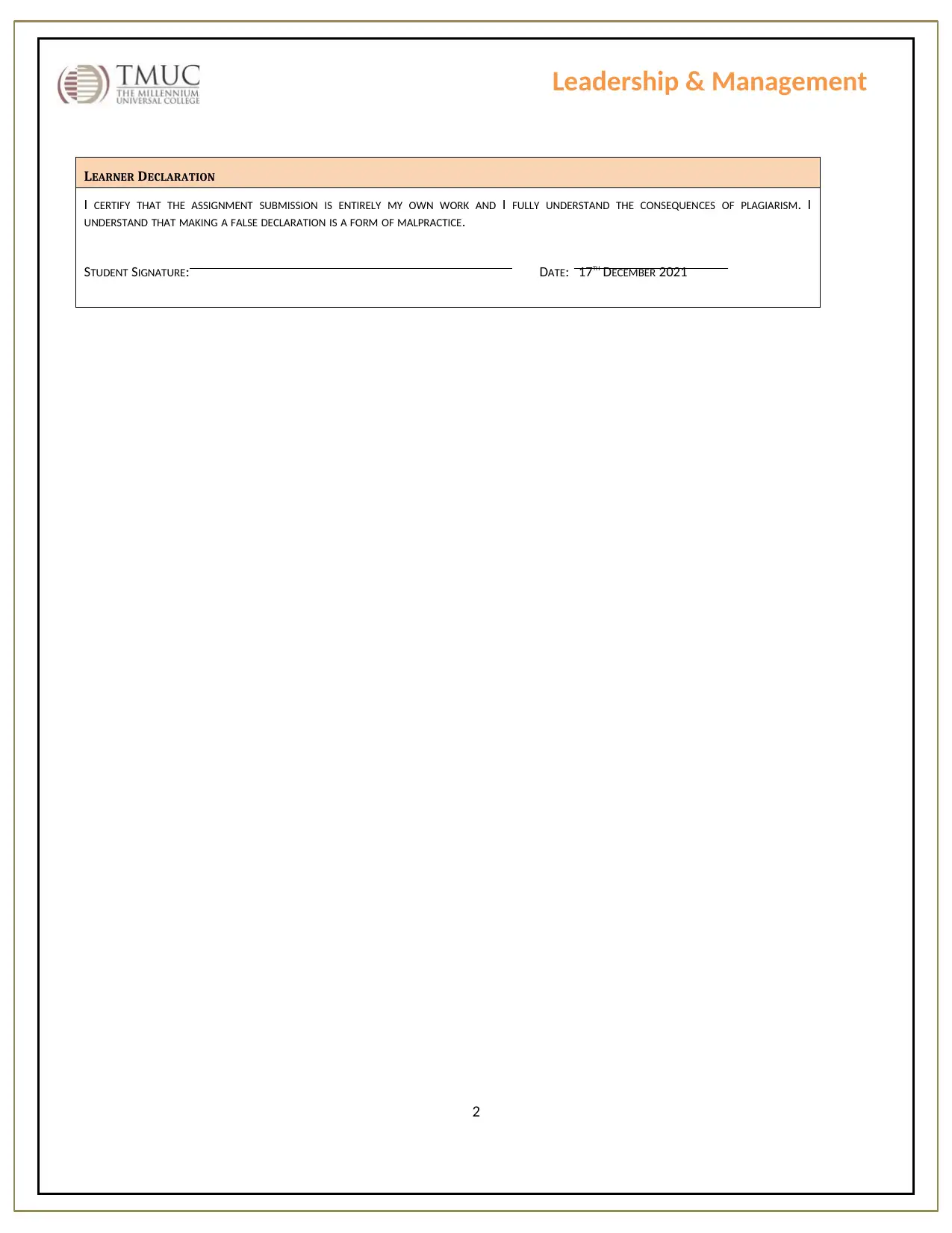
Leadership & Management
LEARNER DECLARATION
I CERTIFY THAT THE ASSIGNMENT SUBMISSION IS ENTIRELY MY OWN WORK AND I FULLY UNDERSTAND THE CONSEQUENCES OF PLAGIARISM. I
UNDERSTAND THAT MAKING A FALSE DECLARATION IS A FORM OF MALPRACTICE.
STUDENT SIGNATURE: DATE: 17TH DECEMBER 2021
2
LEARNER DECLARATION
I CERTIFY THAT THE ASSIGNMENT SUBMISSION IS ENTIRELY MY OWN WORK AND I FULLY UNDERSTAND THE CONSEQUENCES OF PLAGIARISM. I
UNDERSTAND THAT MAKING A FALSE DECLARATION IS A FORM OF MALPRACTICE.
STUDENT SIGNATURE: DATE: 17TH DECEMBER 2021
2
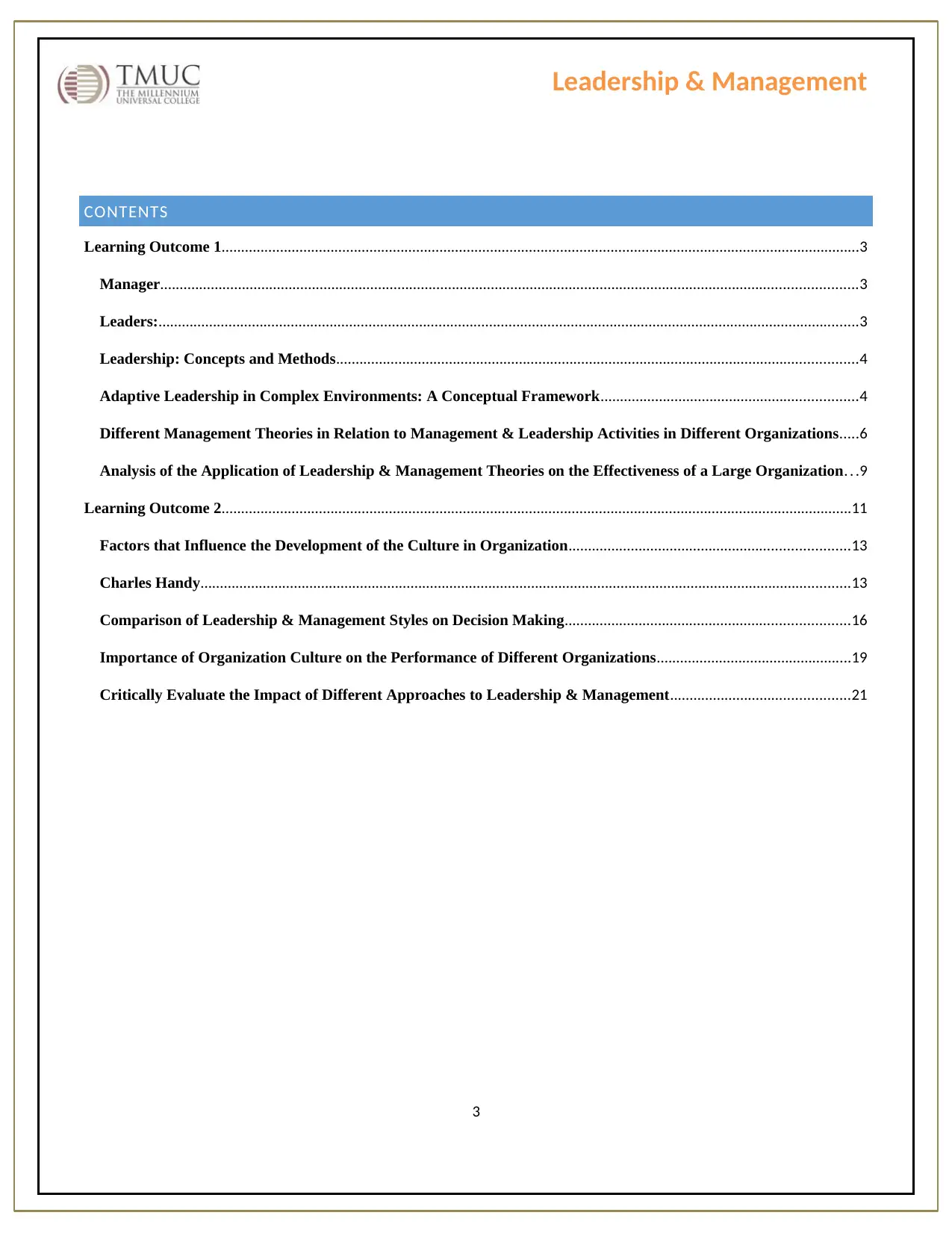
Leadership & Management
CONTENTS
Learning Outcome 1....................................................................................................................................................................3
Manager...................................................................................................................................................................................3
Leaders:....................................................................................................................................................................................3
Leadership: Concepts and Methods......................................................................................................................................4
Adaptive Leadership in Complex Environments: A Conceptual Framework..................................................................4
Different Management Theories in Relation to Management & Leadership Activities in Different Organizations.....6
Analysis of the Application of Leadership & Management Theories on the Effectiveness of a Large Organization. . .9
Learning Outcome 2..................................................................................................................................................................11
Factors that Influence the Development of the Culture in Organization........................................................................13
Charles Handy.......................................................................................................................................................................13
Comparison of Leadership & Management Styles on Decision Making.........................................................................16
Importance of Organization Culture on the Performance of Different Organizations..................................................19
Critically Evaluate the Impact of Different Approaches to Leadership & Management..............................................21
3
CONTENTS
Learning Outcome 1....................................................................................................................................................................3
Manager...................................................................................................................................................................................3
Leaders:....................................................................................................................................................................................3
Leadership: Concepts and Methods......................................................................................................................................4
Adaptive Leadership in Complex Environments: A Conceptual Framework..................................................................4
Different Management Theories in Relation to Management & Leadership Activities in Different Organizations.....6
Analysis of the Application of Leadership & Management Theories on the Effectiveness of a Large Organization. . .9
Learning Outcome 2..................................................................................................................................................................11
Factors that Influence the Development of the Culture in Organization........................................................................13
Charles Handy.......................................................................................................................................................................13
Comparison of Leadership & Management Styles on Decision Making.........................................................................16
Importance of Organization Culture on the Performance of Different Organizations..................................................19
Critically Evaluate the Impact of Different Approaches to Leadership & Management..............................................21
3
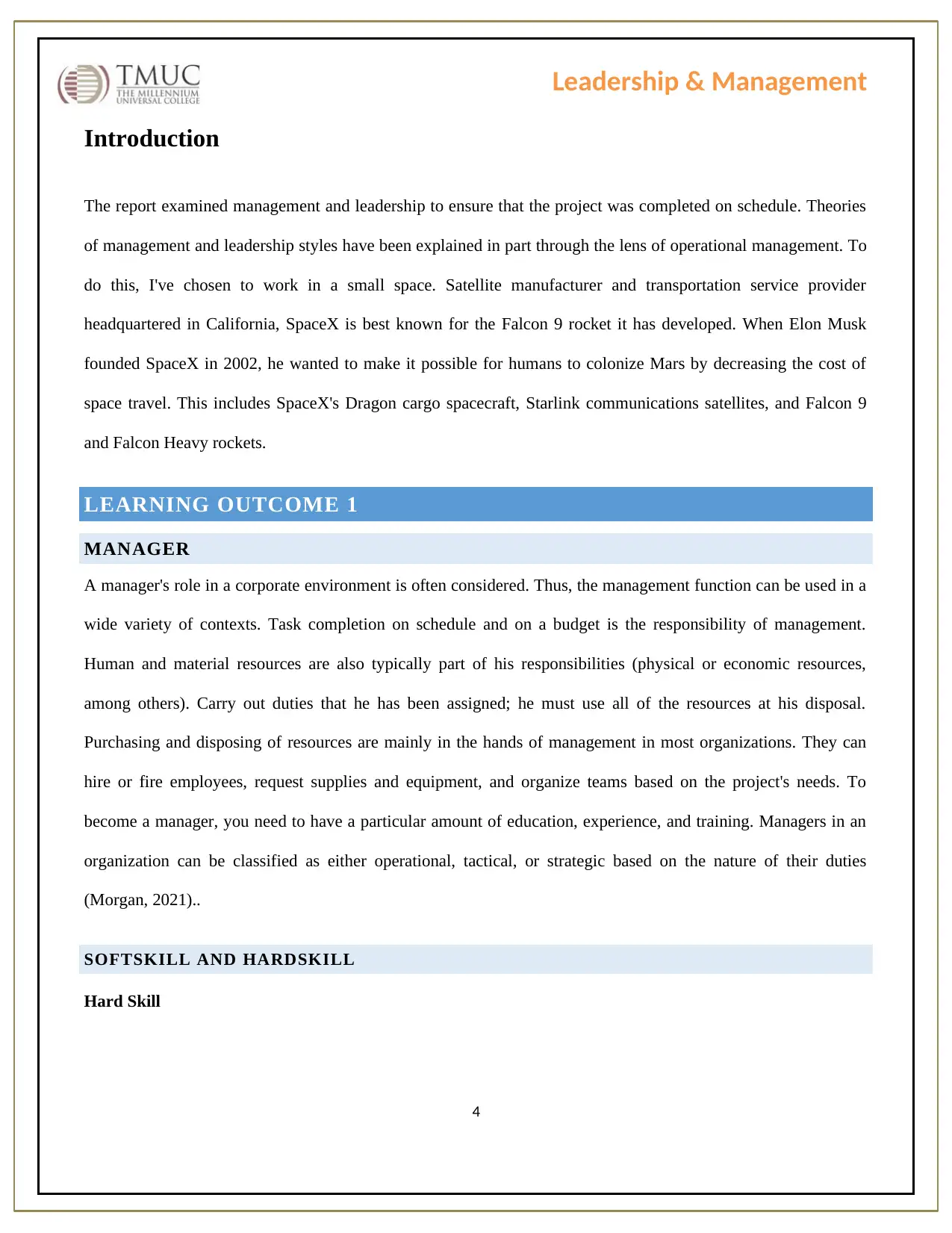
Leadership & Management
Introduction
The report examined management and leadership to ensure that the project was completed on schedule. Theories
of management and leadership styles have been explained in part through the lens of operational management. To
do this, I've chosen to work in a small space. Satellite manufacturer and transportation service provider
headquartered in California, SpaceX is best known for the Falcon 9 rocket it has developed. When Elon Musk
founded SpaceX in 2002, he wanted to make it possible for humans to colonize Mars by decreasing the cost of
space travel. This includes SpaceX's Dragon cargo spacecraft, Starlink communications satellites, and Falcon 9
and Falcon Heavy rockets.
LEARNING OUTCOME 1
MANAGER
A manager's role in a corporate environment is often considered. Thus, the management function can be used in a
wide variety of contexts. Task completion on schedule and on a budget is the responsibility of management.
Human and material resources are also typically part of his responsibilities (physical or economic resources,
among others). Carry out duties that he has been assigned; he must use all of the resources at his disposal.
Purchasing and disposing of resources are mainly in the hands of management in most organizations. They can
hire or fire employees, request supplies and equipment, and organize teams based on the project's needs. To
become a manager, you need to have a particular amount of education, experience, and training. Managers in an
organization can be classified as either operational, tactical, or strategic based on the nature of their duties
(Morgan, 2021)..
SOFTSKILL AND HARDSKILL
Hard Skill
4
Introduction
The report examined management and leadership to ensure that the project was completed on schedule. Theories
of management and leadership styles have been explained in part through the lens of operational management. To
do this, I've chosen to work in a small space. Satellite manufacturer and transportation service provider
headquartered in California, SpaceX is best known for the Falcon 9 rocket it has developed. When Elon Musk
founded SpaceX in 2002, he wanted to make it possible for humans to colonize Mars by decreasing the cost of
space travel. This includes SpaceX's Dragon cargo spacecraft, Starlink communications satellites, and Falcon 9
and Falcon Heavy rockets.
LEARNING OUTCOME 1
MANAGER
A manager's role in a corporate environment is often considered. Thus, the management function can be used in a
wide variety of contexts. Task completion on schedule and on a budget is the responsibility of management.
Human and material resources are also typically part of his responsibilities (physical or economic resources,
among others). Carry out duties that he has been assigned; he must use all of the resources at his disposal.
Purchasing and disposing of resources are mainly in the hands of management in most organizations. They can
hire or fire employees, request supplies and equipment, and organize teams based on the project's needs. To
become a manager, you need to have a particular amount of education, experience, and training. Managers in an
organization can be classified as either operational, tactical, or strategic based on the nature of their duties
(Morgan, 2021)..
SOFTSKILL AND HARDSKILL
Hard Skill
4
Secure Best Marks with AI Grader
Need help grading? Try our AI Grader for instant feedback on your assignments.
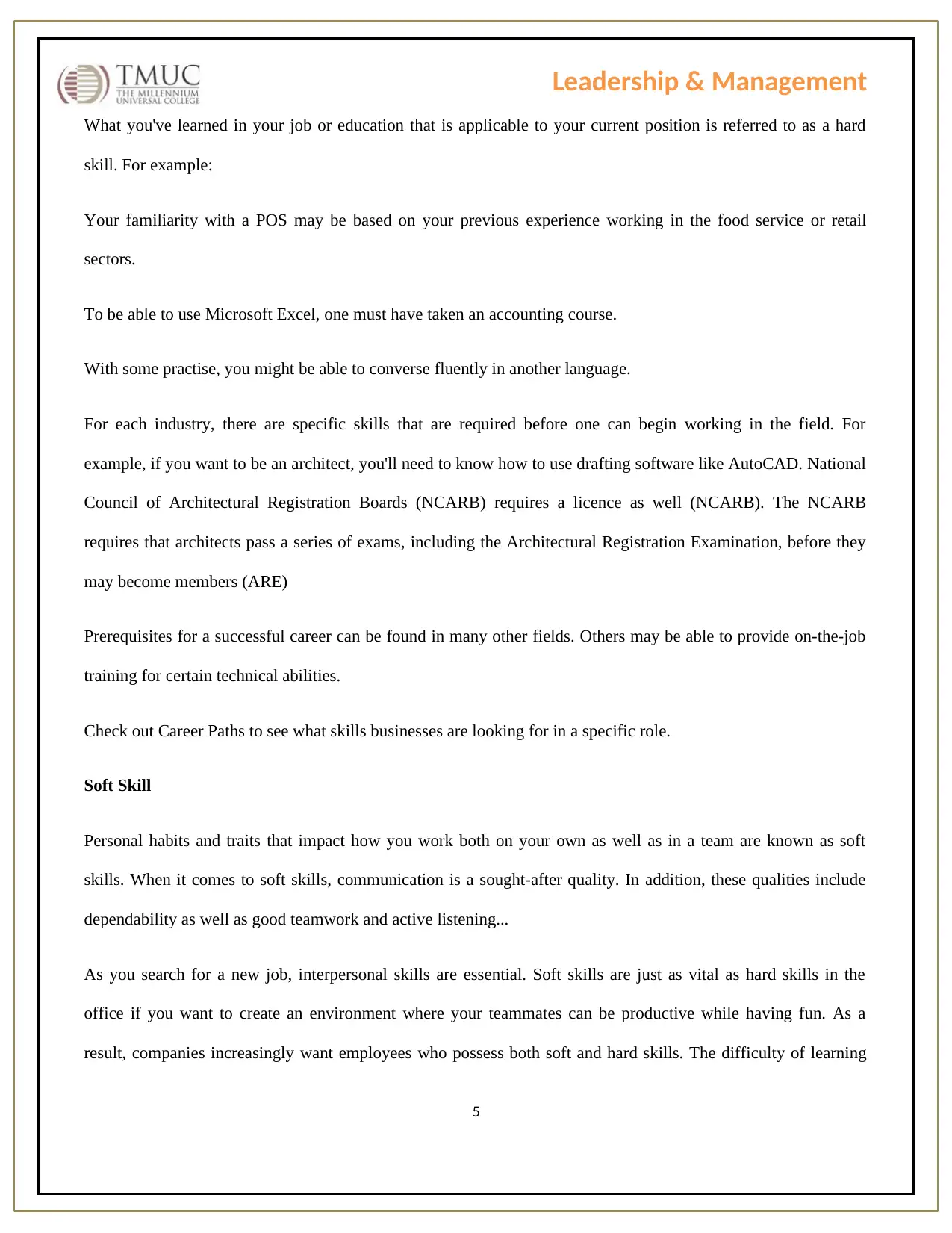
Leadership & Management
What you've learned in your job or education that is applicable to your current position is referred to as a hard
skill. For example:
Your familiarity with a POS may be based on your previous experience working in the food service or retail
sectors.
To be able to use Microsoft Excel, one must have taken an accounting course.
With some practise, you might be able to converse fluently in another language.
For each industry, there are specific skills that are required before one can begin working in the field. For
example, if you want to be an architect, you'll need to know how to use drafting software like AutoCAD. National
Council of Architectural Registration Boards (NCARB) requires a licence as well (NCARB). The NCARB
requires that architects pass a series of exams, including the Architectural Registration Examination, before they
may become members (ARE)
Prerequisites for a successful career can be found in many other fields. Others may be able to provide on-the-job
training for certain technical abilities.
Check out Career Paths to see what skills businesses are looking for in a specific role.
Soft Skill
Personal habits and traits that impact how you work both on your own as well as in a team are known as soft
skills. When it comes to soft skills, communication is a sought-after quality. In addition, these qualities include
dependability as well as good teamwork and active listening...
As you search for a new job, interpersonal skills are essential. Soft skills are just as vital as hard skills in the
office if you want to create an environment where your teammates can be productive while having fun. As a
result, companies increasingly want employees who possess both soft and hard skills. The difficulty of learning
5
What you've learned in your job or education that is applicable to your current position is referred to as a hard
skill. For example:
Your familiarity with a POS may be based on your previous experience working in the food service or retail
sectors.
To be able to use Microsoft Excel, one must have taken an accounting course.
With some practise, you might be able to converse fluently in another language.
For each industry, there are specific skills that are required before one can begin working in the field. For
example, if you want to be an architect, you'll need to know how to use drafting software like AutoCAD. National
Council of Architectural Registration Boards (NCARB) requires a licence as well (NCARB). The NCARB
requires that architects pass a series of exams, including the Architectural Registration Examination, before they
may become members (ARE)
Prerequisites for a successful career can be found in many other fields. Others may be able to provide on-the-job
training for certain technical abilities.
Check out Career Paths to see what skills businesses are looking for in a specific role.
Soft Skill
Personal habits and traits that impact how you work both on your own as well as in a team are known as soft
skills. When it comes to soft skills, communication is a sought-after quality. In addition, these qualities include
dependability as well as good teamwork and active listening...
As you search for a new job, interpersonal skills are essential. Soft skills are just as vital as hard skills in the
office if you want to create an environment where your teammates can be productive while having fun. As a
result, companies increasingly want employees who possess both soft and hard skills. The difficulty of learning
5
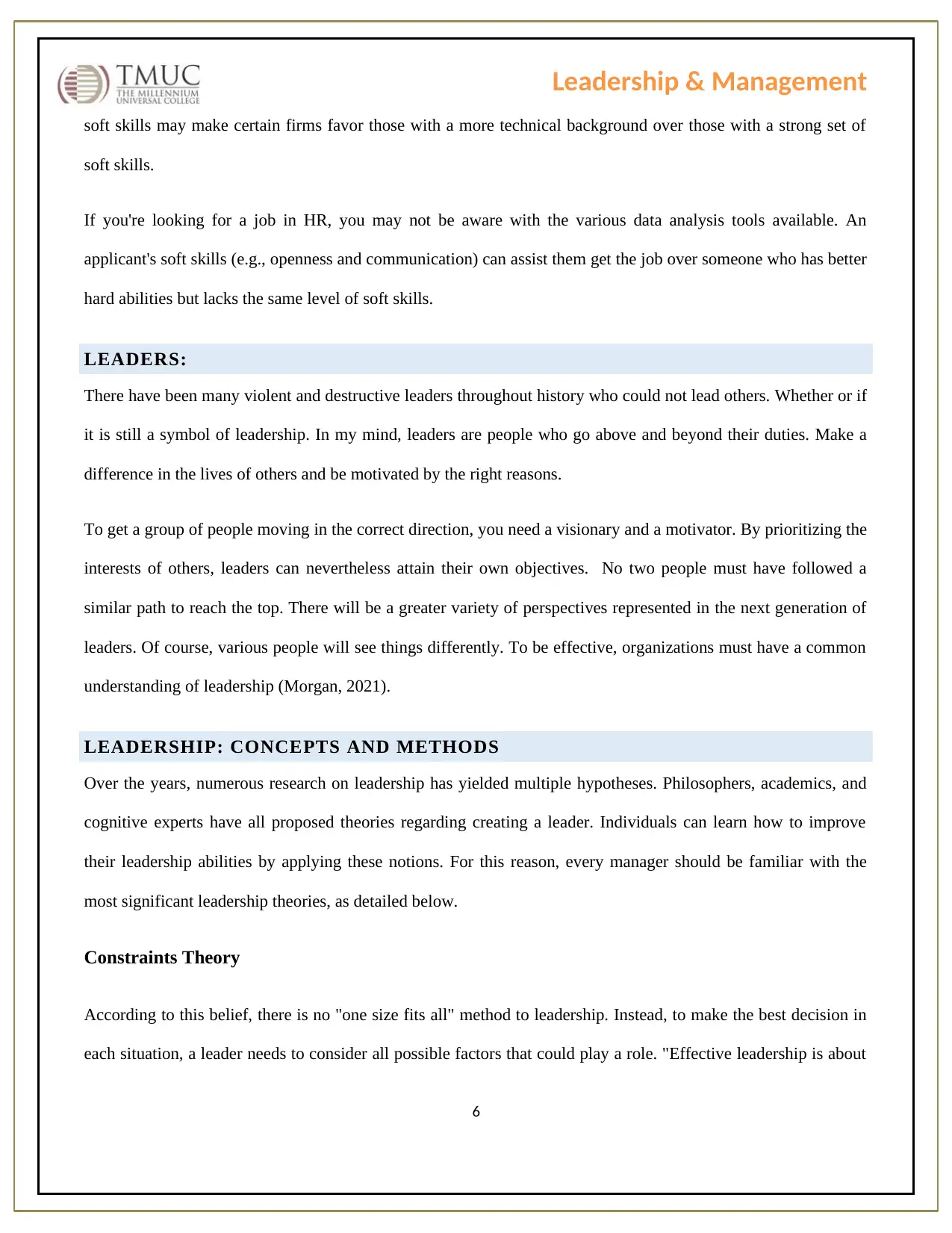
Leadership & Management
soft skills may make certain firms favor those with a more technical background over those with a strong set of
soft skills.
If you're looking for a job in HR, you may not be aware with the various data analysis tools available. An
applicant's soft skills (e.g., openness and communication) can assist them get the job over someone who has better
hard abilities but lacks the same level of soft skills.
LEADERS:
There have been many violent and destructive leaders throughout history who could not lead others. Whether or if
it is still a symbol of leadership. In my mind, leaders are people who go above and beyond their duties. Make a
difference in the lives of others and be motivated by the right reasons.
To get a group of people moving in the correct direction, you need a visionary and a motivator. By prioritizing the
interests of others, leaders can nevertheless attain their own objectives. No two people must have followed a
similar path to reach the top. There will be a greater variety of perspectives represented in the next generation of
leaders. Of course, various people will see things differently. To be effective, organizations must have a common
understanding of leadership (Morgan, 2021).
LEADERSHIP: CONCEPTS AND METHODS
Over the years, numerous research on leadership has yielded multiple hypotheses. Philosophers, academics, and
cognitive experts have all proposed theories regarding creating a leader. Individuals can learn how to improve
their leadership abilities by applying these notions. For this reason, every manager should be familiar with the
most significant leadership theories, as detailed below.
Constraints Theory
According to this belief, there is no "one size fits all" method to leadership. Instead, to make the best decision in
each situation, a leader needs to consider all possible factors that could play a role. "Effective leadership is about
6
soft skills may make certain firms favor those with a more technical background over those with a strong set of
soft skills.
If you're looking for a job in HR, you may not be aware with the various data analysis tools available. An
applicant's soft skills (e.g., openness and communication) can assist them get the job over someone who has better
hard abilities but lacks the same level of soft skills.
LEADERS:
There have been many violent and destructive leaders throughout history who could not lead others. Whether or if
it is still a symbol of leadership. In my mind, leaders are people who go above and beyond their duties. Make a
difference in the lives of others and be motivated by the right reasons.
To get a group of people moving in the correct direction, you need a visionary and a motivator. By prioritizing the
interests of others, leaders can nevertheless attain their own objectives. No two people must have followed a
similar path to reach the top. There will be a greater variety of perspectives represented in the next generation of
leaders. Of course, various people will see things differently. To be effective, organizations must have a common
understanding of leadership (Morgan, 2021).
LEADERSHIP: CONCEPTS AND METHODS
Over the years, numerous research on leadership has yielded multiple hypotheses. Philosophers, academics, and
cognitive experts have all proposed theories regarding creating a leader. Individuals can learn how to improve
their leadership abilities by applying these notions. For this reason, every manager should be familiar with the
most significant leadership theories, as detailed below.
Constraints Theory
According to this belief, there is no "one size fits all" method to leadership. Instead, to make the best decision in
each situation, a leader needs to consider all possible factors that could play a role. "Effective leadership is about
6
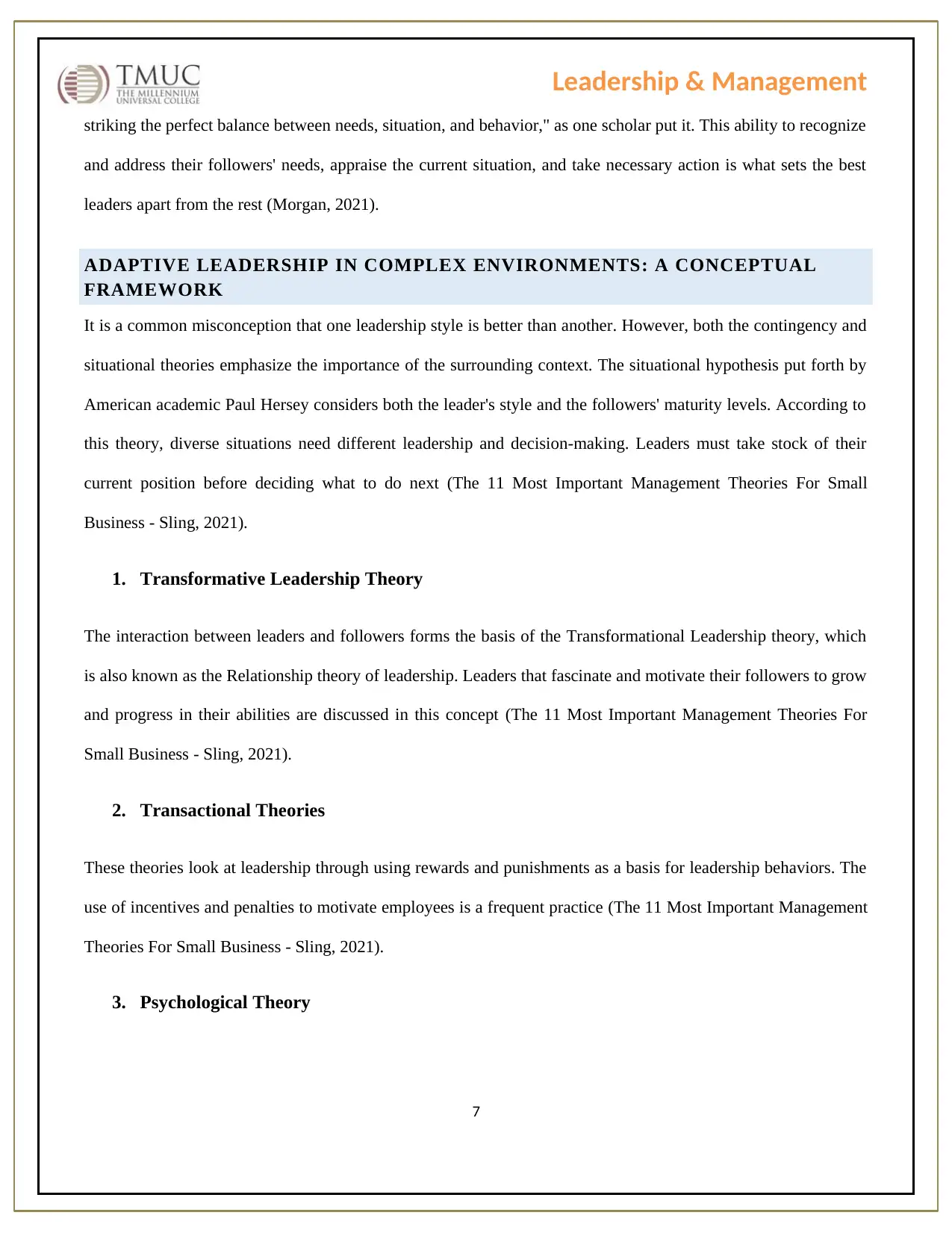
Leadership & Management
striking the perfect balance between needs, situation, and behavior," as one scholar put it. This ability to recognize
and address their followers' needs, appraise the current situation, and take necessary action is what sets the best
leaders apart from the rest (Morgan, 2021).
ADAPTIVE LEADERSHIP IN COMPLEX ENVIRONMENTS: A CONCEPTUAL
FRAMEWORK
It is a common misconception that one leadership style is better than another. However, both the contingency and
situational theories emphasize the importance of the surrounding context. The situational hypothesis put forth by
American academic Paul Hersey considers both the leader's style and the followers' maturity levels. According to
this theory, diverse situations need different leadership and decision-making. Leaders must take stock of their
current position before deciding what to do next (The 11 Most Important Management Theories For Small
Business - Sling, 2021).
1. Transformative Leadership Theory
The interaction between leaders and followers forms the basis of the Transformational Leadership theory, which
is also known as the Relationship theory of leadership. Leaders that fascinate and motivate their followers to grow
and progress in their abilities are discussed in this concept (The 11 Most Important Management Theories For
Small Business - Sling, 2021).
2. Transactional Theories
These theories look at leadership through using rewards and punishments as a basis for leadership behaviors. The
use of incentives and penalties to motivate employees is a frequent practice (The 11 Most Important Management
Theories For Small Business - Sling, 2021).
3. Psychological Theory
7
striking the perfect balance between needs, situation, and behavior," as one scholar put it. This ability to recognize
and address their followers' needs, appraise the current situation, and take necessary action is what sets the best
leaders apart from the rest (Morgan, 2021).
ADAPTIVE LEADERSHIP IN COMPLEX ENVIRONMENTS: A CONCEPTUAL
FRAMEWORK
It is a common misconception that one leadership style is better than another. However, both the contingency and
situational theories emphasize the importance of the surrounding context. The situational hypothesis put forth by
American academic Paul Hersey considers both the leader's style and the followers' maturity levels. According to
this theory, diverse situations need different leadership and decision-making. Leaders must take stock of their
current position before deciding what to do next (The 11 Most Important Management Theories For Small
Business - Sling, 2021).
1. Transformative Leadership Theory
The interaction between leaders and followers forms the basis of the Transformational Leadership theory, which
is also known as the Relationship theory of leadership. Leaders that fascinate and motivate their followers to grow
and progress in their abilities are discussed in this concept (The 11 Most Important Management Theories For
Small Business - Sling, 2021).
2. Transactional Theories
These theories look at leadership through using rewards and punishments as a basis for leadership behaviors. The
use of incentives and penalties to motivate employees is a frequent practice (The 11 Most Important Management
Theories For Small Business - Sling, 2021).
3. Psychological Theory
7
Paraphrase This Document
Need a fresh take? Get an instant paraphrase of this document with our AI Paraphraser
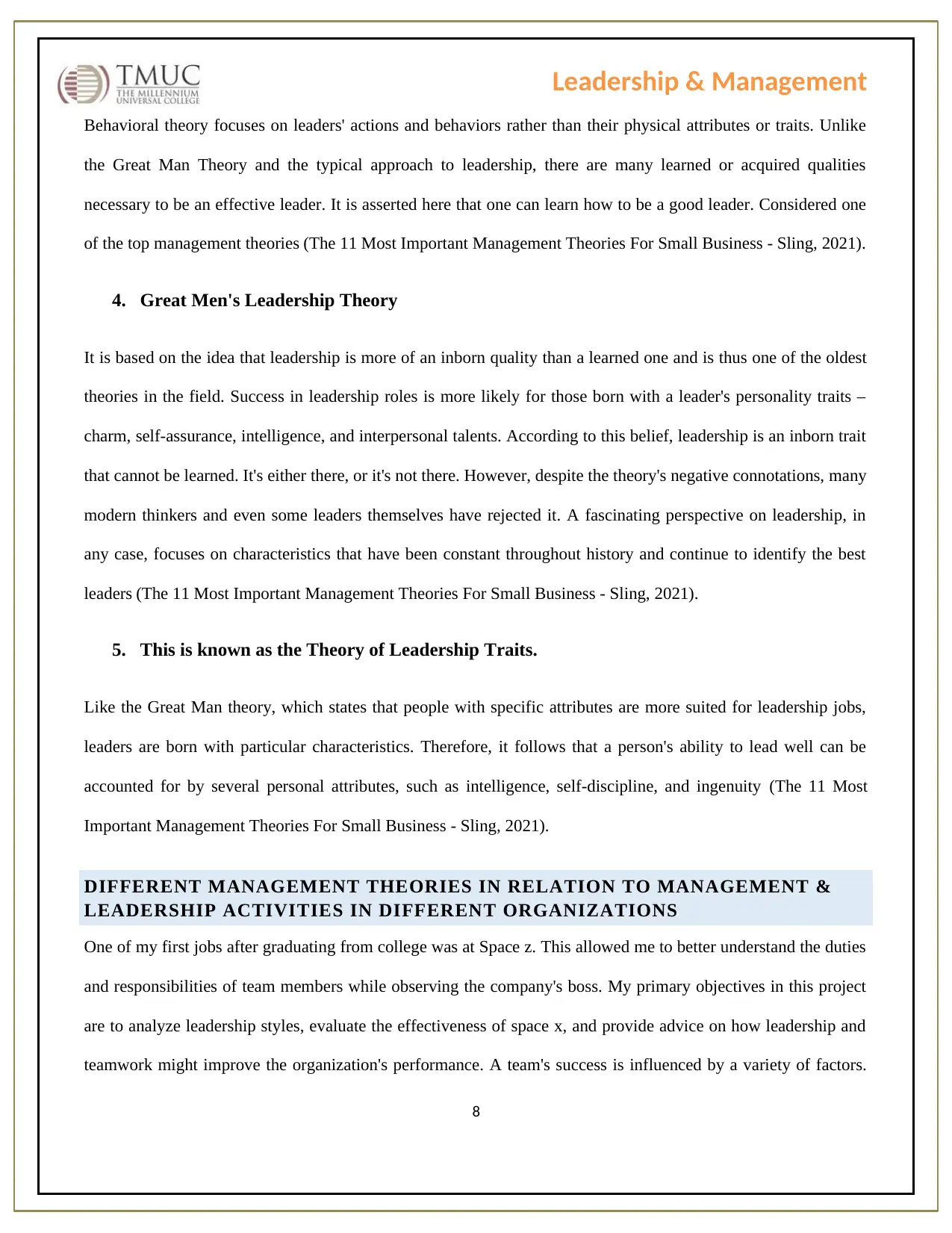
Leadership & Management
Behavioral theory focuses on leaders' actions and behaviors rather than their physical attributes or traits. Unlike
the Great Man Theory and the typical approach to leadership, there are many learned or acquired qualities
necessary to be an effective leader. It is asserted here that one can learn how to be a good leader. Considered one
of the top management theories (The 11 Most Important Management Theories For Small Business - Sling, 2021).
4. Great Men's Leadership Theory
It is based on the idea that leadership is more of an inborn quality than a learned one and is thus one of the oldest
theories in the field. Success in leadership roles is more likely for those born with a leader's personality traits –
charm, self-assurance, intelligence, and interpersonal talents. According to this belief, leadership is an inborn trait
that cannot be learned. It's either there, or it's not there. However, despite the theory's negative connotations, many
modern thinkers and even some leaders themselves have rejected it. A fascinating perspective on leadership, in
any case, focuses on characteristics that have been constant throughout history and continue to identify the best
leaders (The 11 Most Important Management Theories For Small Business - Sling, 2021).
5. This is known as the Theory of Leadership Traits.
Like the Great Man theory, which states that people with specific attributes are more suited for leadership jobs,
leaders are born with particular characteristics. Therefore, it follows that a person's ability to lead well can be
accounted for by several personal attributes, such as intelligence, self-discipline, and ingenuity (The 11 Most
Important Management Theories For Small Business - Sling, 2021).
DIFFERENT MANAGEMENT THEORIES IN RELATION TO MANAGEMENT &
LEADERSHIP ACTIVITIES IN DIFFERENT ORGANIZATIONS
One of my first jobs after graduating from college was at Space z. This allowed me to better understand the duties
and responsibilities of team members while observing the company's boss. My primary objectives in this project
are to analyze leadership styles, evaluate the effectiveness of space x, and provide advice on how leadership and
teamwork might improve the organization's performance. A team's success is influenced by a variety of factors.
8
Behavioral theory focuses on leaders' actions and behaviors rather than their physical attributes or traits. Unlike
the Great Man Theory and the typical approach to leadership, there are many learned or acquired qualities
necessary to be an effective leader. It is asserted here that one can learn how to be a good leader. Considered one
of the top management theories (The 11 Most Important Management Theories For Small Business - Sling, 2021).
4. Great Men's Leadership Theory
It is based on the idea that leadership is more of an inborn quality than a learned one and is thus one of the oldest
theories in the field. Success in leadership roles is more likely for those born with a leader's personality traits –
charm, self-assurance, intelligence, and interpersonal talents. According to this belief, leadership is an inborn trait
that cannot be learned. It's either there, or it's not there. However, despite the theory's negative connotations, many
modern thinkers and even some leaders themselves have rejected it. A fascinating perspective on leadership, in
any case, focuses on characteristics that have been constant throughout history and continue to identify the best
leaders (The 11 Most Important Management Theories For Small Business - Sling, 2021).
5. This is known as the Theory of Leadership Traits.
Like the Great Man theory, which states that people with specific attributes are more suited for leadership jobs,
leaders are born with particular characteristics. Therefore, it follows that a person's ability to lead well can be
accounted for by several personal attributes, such as intelligence, self-discipline, and ingenuity (The 11 Most
Important Management Theories For Small Business - Sling, 2021).
DIFFERENT MANAGEMENT THEORIES IN RELATION TO MANAGEMENT &
LEADERSHIP ACTIVITIES IN DIFFERENT ORGANIZATIONS
One of my first jobs after graduating from college was at Space z. This allowed me to better understand the duties
and responsibilities of team members while observing the company's boss. My primary objectives in this project
are to analyze leadership styles, evaluate the effectiveness of space x, and provide advice on how leadership and
teamwork might improve the organization's performance. A team's success is influenced by a variety of factors.
8
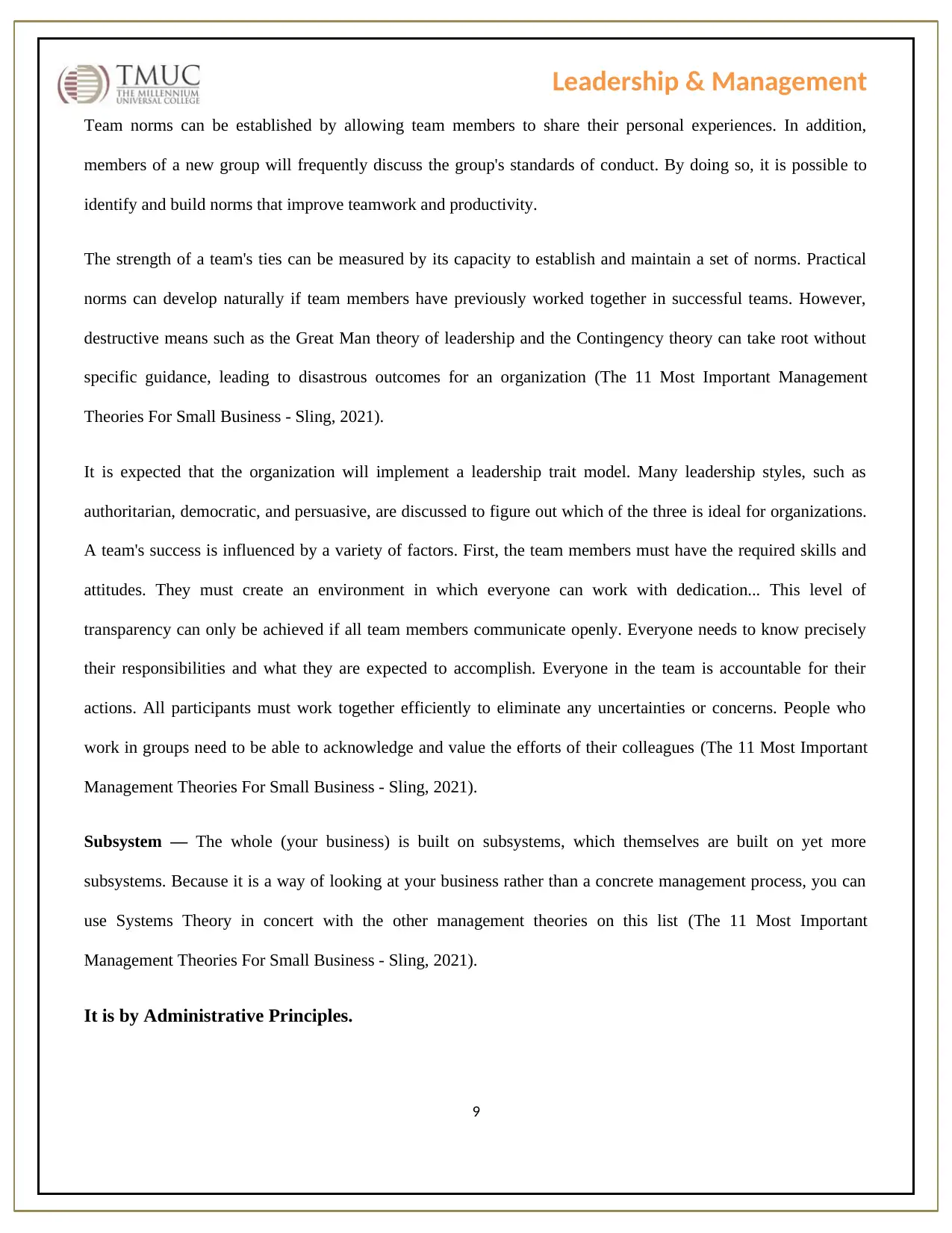
Leadership & Management
Team norms can be established by allowing team members to share their personal experiences. In addition,
members of a new group will frequently discuss the group's standards of conduct. By doing so, it is possible to
identify and build norms that improve teamwork and productivity.
The strength of a team's ties can be measured by its capacity to establish and maintain a set of norms. Practical
norms can develop naturally if team members have previously worked together in successful teams. However,
destructive means such as the Great Man theory of leadership and the Contingency theory can take root without
specific guidance, leading to disastrous outcomes for an organization (The 11 Most Important Management
Theories For Small Business - Sling, 2021).
It is expected that the organization will implement a leadership trait model. Many leadership styles, such as
authoritarian, democratic, and persuasive, are discussed to figure out which of the three is ideal for organizations.
A team's success is influenced by a variety of factors. First, the team members must have the required skills and
attitudes. They must create an environment in which everyone can work with dedication... This level of
transparency can only be achieved if all team members communicate openly. Everyone needs to know precisely
their responsibilities and what they are expected to accomplish. Everyone in the team is accountable for their
actions. All participants must work together efficiently to eliminate any uncertainties or concerns. People who
work in groups need to be able to acknowledge and value the efforts of their colleagues (The 11 Most Important
Management Theories For Small Business - Sling, 2021).
Subsystem — The whole (your business) is built on subsystems, which themselves are built on yet more
subsystems. Because it is a way of looking at your business rather than a concrete management process, you can
use Systems Theory in concert with the other management theories on this list (The 11 Most Important
Management Theories For Small Business - Sling, 2021).
It is by Administrative Principles.
9
Team norms can be established by allowing team members to share their personal experiences. In addition,
members of a new group will frequently discuss the group's standards of conduct. By doing so, it is possible to
identify and build norms that improve teamwork and productivity.
The strength of a team's ties can be measured by its capacity to establish and maintain a set of norms. Practical
norms can develop naturally if team members have previously worked together in successful teams. However,
destructive means such as the Great Man theory of leadership and the Contingency theory can take root without
specific guidance, leading to disastrous outcomes for an organization (The 11 Most Important Management
Theories For Small Business - Sling, 2021).
It is expected that the organization will implement a leadership trait model. Many leadership styles, such as
authoritarian, democratic, and persuasive, are discussed to figure out which of the three is ideal for organizations.
A team's success is influenced by a variety of factors. First, the team members must have the required skills and
attitudes. They must create an environment in which everyone can work with dedication... This level of
transparency can only be achieved if all team members communicate openly. Everyone needs to know precisely
their responsibilities and what they are expected to accomplish. Everyone in the team is accountable for their
actions. All participants must work together efficiently to eliminate any uncertainties or concerns. People who
work in groups need to be able to acknowledge and value the efforts of their colleagues (The 11 Most Important
Management Theories For Small Business - Sling, 2021).
Subsystem — The whole (your business) is built on subsystems, which themselves are built on yet more
subsystems. Because it is a way of looking at your business rather than a concrete management process, you can
use Systems Theory in concert with the other management theories on this list (The 11 Most Important
Management Theories For Small Business - Sling, 2021).
It is by Administrative Principles.
9
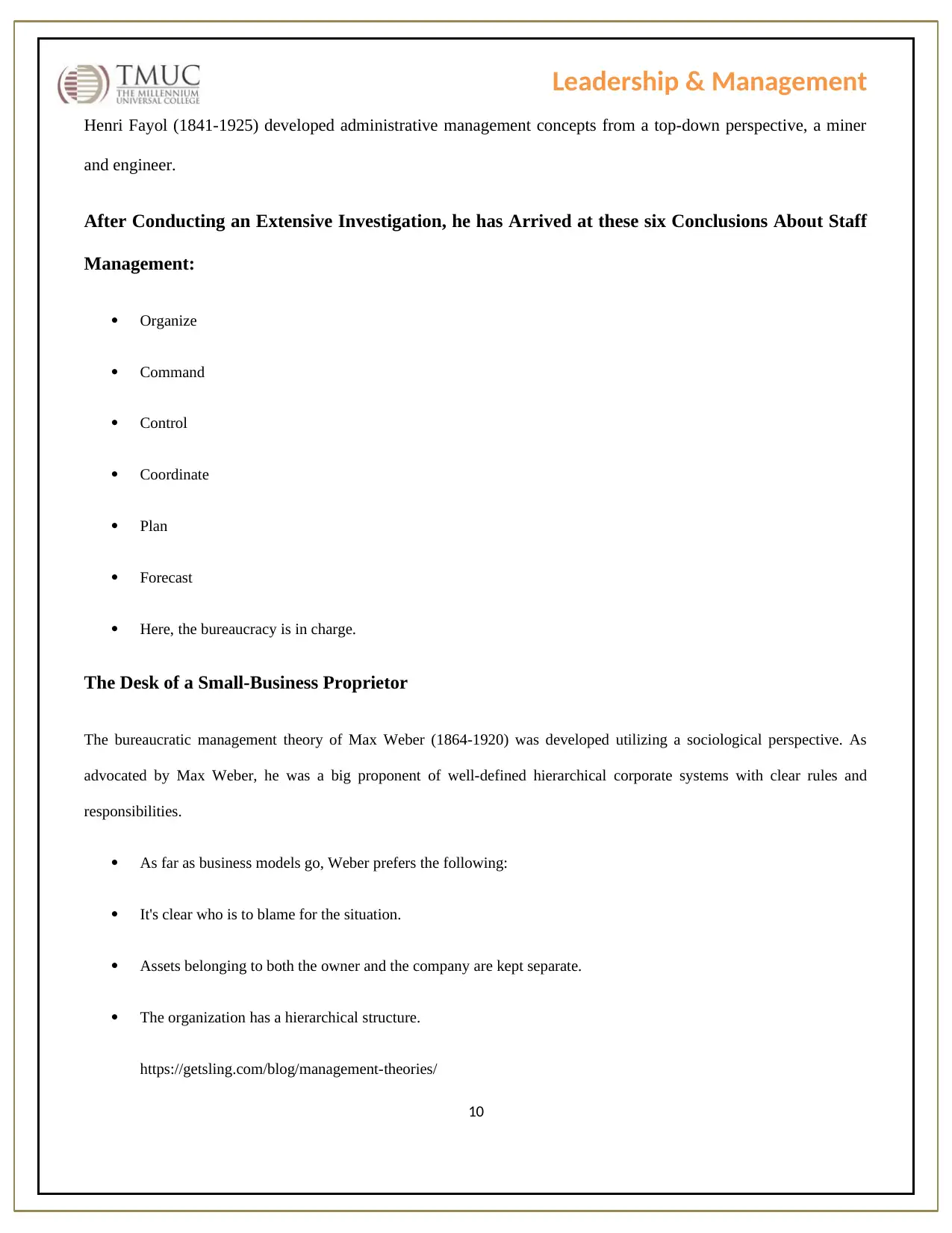
Leadership & Management
Henri Fayol (1841-1925) developed administrative management concepts from a top-down perspective, a miner
and engineer.
After Conducting an Extensive Investigation, he has Arrived at these six Conclusions About Staff
Management:
Organize
Command
Control
Coordinate
Plan
Forecast
Here, the bureaucracy is in charge.
The Desk of a Small-Business Proprietor
The bureaucratic management theory of Max Weber (1864-1920) was developed utilizing a sociological perspective. As
advocated by Max Weber, he was a big proponent of well-defined hierarchical corporate systems with clear rules and
responsibilities.
As far as business models go, Weber prefers the following:
It's clear who is to blame for the situation.
Assets belonging to both the owner and the company are kept separate.
The organization has a hierarchical structure.
https://getsling.com/blog/management-theories/
10
Henri Fayol (1841-1925) developed administrative management concepts from a top-down perspective, a miner
and engineer.
After Conducting an Extensive Investigation, he has Arrived at these six Conclusions About Staff
Management:
Organize
Command
Control
Coordinate
Plan
Forecast
Here, the bureaucracy is in charge.
The Desk of a Small-Business Proprietor
The bureaucratic management theory of Max Weber (1864-1920) was developed utilizing a sociological perspective. As
advocated by Max Weber, he was a big proponent of well-defined hierarchical corporate systems with clear rules and
responsibilities.
As far as business models go, Weber prefers the following:
It's clear who is to blame for the situation.
Assets belonging to both the owner and the company are kept separate.
The organization has a hierarchical structure.
https://getsling.com/blog/management-theories/
10
Secure Best Marks with AI Grader
Need help grading? Try our AI Grader for instant feedback on your assignments.
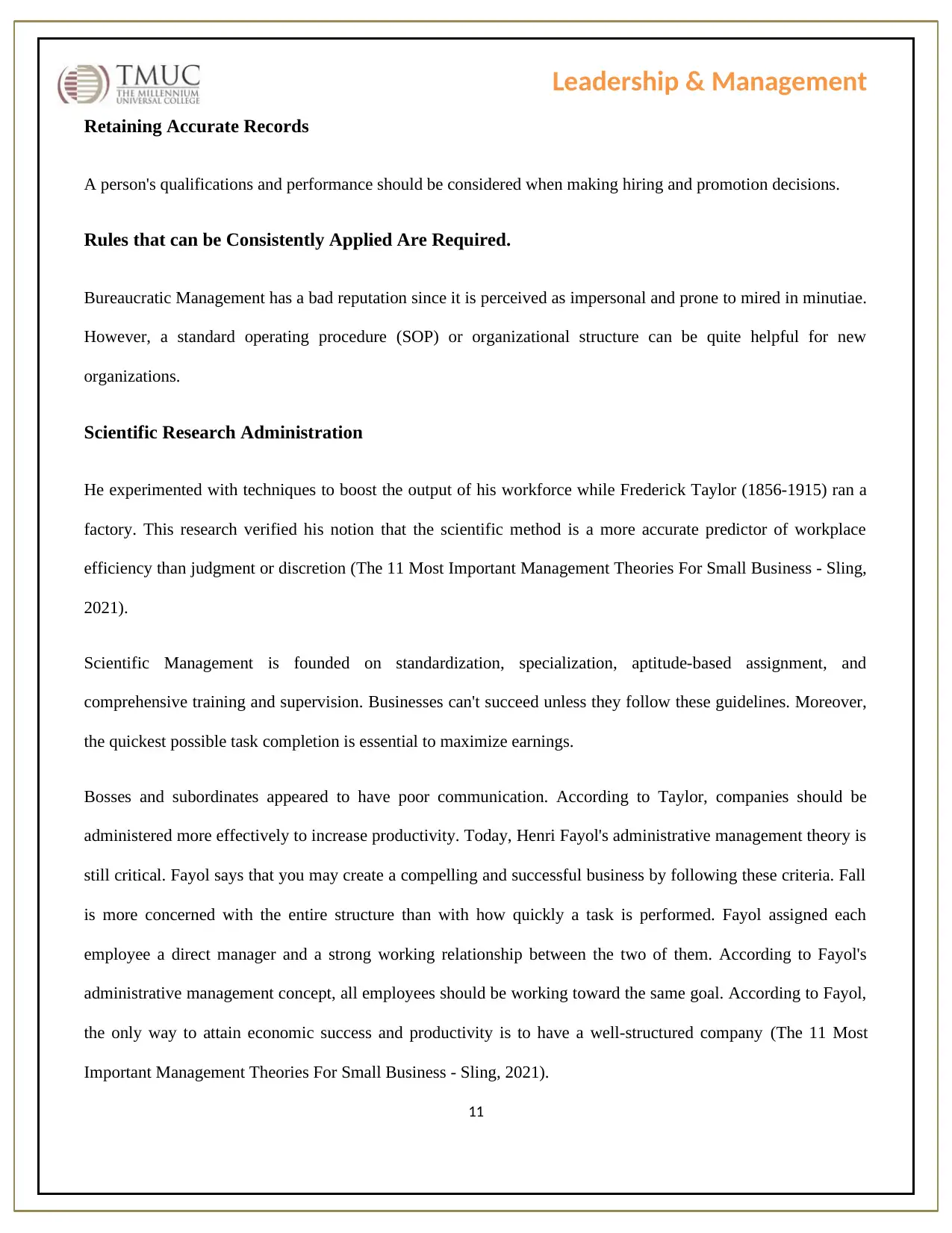
Leadership & Management
Retaining Accurate Records
A person's qualifications and performance should be considered when making hiring and promotion decisions.
Rules that can be Consistently Applied Are Required.
Bureaucratic Management has a bad reputation since it is perceived as impersonal and prone to mired in minutiae.
However, a standard operating procedure (SOP) or organizational structure can be quite helpful for new
organizations.
Scientific Research Administration
He experimented with techniques to boost the output of his workforce while Frederick Taylor (1856-1915) ran a
factory. This research verified his notion that the scientific method is a more accurate predictor of workplace
efficiency than judgment or discretion (The 11 Most Important Management Theories For Small Business - Sling,
2021).
Scientific Management is founded on standardization, specialization, aptitude-based assignment, and
comprehensive training and supervision. Businesses can't succeed unless they follow these guidelines. Moreover,
the quickest possible task completion is essential to maximize earnings.
Bosses and subordinates appeared to have poor communication. According to Taylor, companies should be
administered more effectively to increase productivity. Today, Henri Fayol's administrative management theory is
still critical. Fayol says that you may create a compelling and successful business by following these criteria. Fall
is more concerned with the entire structure than with how quickly a task is performed. Fayol assigned each
employee a direct manager and a strong working relationship between the two of them. According to Fayol's
administrative management concept, all employees should be working toward the same goal. According to Fayol,
the only way to attain economic success and productivity is to have a well-structured company (The 11 Most
Important Management Theories For Small Business - Sling, 2021).
11
Retaining Accurate Records
A person's qualifications and performance should be considered when making hiring and promotion decisions.
Rules that can be Consistently Applied Are Required.
Bureaucratic Management has a bad reputation since it is perceived as impersonal and prone to mired in minutiae.
However, a standard operating procedure (SOP) or organizational structure can be quite helpful for new
organizations.
Scientific Research Administration
He experimented with techniques to boost the output of his workforce while Frederick Taylor (1856-1915) ran a
factory. This research verified his notion that the scientific method is a more accurate predictor of workplace
efficiency than judgment or discretion (The 11 Most Important Management Theories For Small Business - Sling,
2021).
Scientific Management is founded on standardization, specialization, aptitude-based assignment, and
comprehensive training and supervision. Businesses can't succeed unless they follow these guidelines. Moreover,
the quickest possible task completion is essential to maximize earnings.
Bosses and subordinates appeared to have poor communication. According to Taylor, companies should be
administered more effectively to increase productivity. Today, Henri Fayol's administrative management theory is
still critical. Fayol says that you may create a compelling and successful business by following these criteria. Fall
is more concerned with the entire structure than with how quickly a task is performed. Fayol assigned each
employee a direct manager and a strong working relationship between the two of them. According to Fayol's
administrative management concept, all employees should be working toward the same goal. According to Fayol,
the only way to attain economic success and productivity is to have a well-structured company (The 11 Most
Important Management Theories For Small Business - Sling, 2021).
11
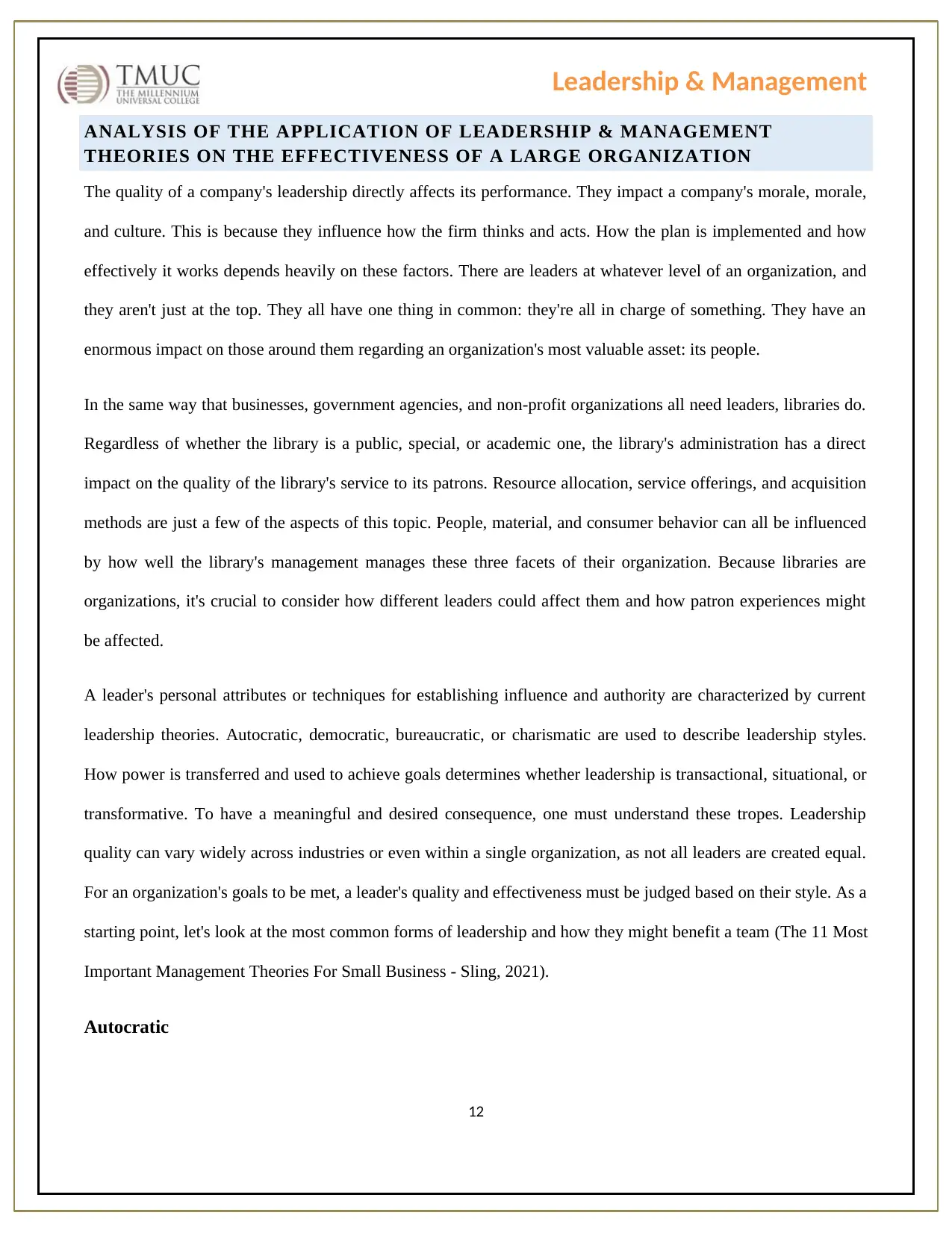
Leadership & Management
ANALYSIS OF THE APPLICATION OF LEADERSHIP & MANAGEMENT
THEORIES ON THE EFFECTIVENESS OF A LARGE ORGANIZATION
The quality of a company's leadership directly affects its performance. They impact a company's morale, morale,
and culture. This is because they influence how the firm thinks and acts. How the plan is implemented and how
effectively it works depends heavily on these factors. There are leaders at whatever level of an organization, and
they aren't just at the top. They all have one thing in common: they're all in charge of something. They have an
enormous impact on those around them regarding an organization's most valuable asset: its people.
In the same way that businesses, government agencies, and non-profit organizations all need leaders, libraries do.
Regardless of whether the library is a public, special, or academic one, the library's administration has a direct
impact on the quality of the library's service to its patrons. Resource allocation, service offerings, and acquisition
methods are just a few of the aspects of this topic. People, material, and consumer behavior can all be influenced
by how well the library's management manages these three facets of their organization. Because libraries are
organizations, it's crucial to consider how different leaders could affect them and how patron experiences might
be affected.
A leader's personal attributes or techniques for establishing influence and authority are characterized by current
leadership theories. Autocratic, democratic, bureaucratic, or charismatic are used to describe leadership styles.
How power is transferred and used to achieve goals determines whether leadership is transactional, situational, or
transformative. To have a meaningful and desired consequence, one must understand these tropes. Leadership
quality can vary widely across industries or even within a single organization, as not all leaders are created equal.
For an organization's goals to be met, a leader's quality and effectiveness must be judged based on their style. As a
starting point, let's look at the most common forms of leadership and how they might benefit a team (The 11 Most
Important Management Theories For Small Business - Sling, 2021).
Autocratic
12
ANALYSIS OF THE APPLICATION OF LEADERSHIP & MANAGEMENT
THEORIES ON THE EFFECTIVENESS OF A LARGE ORGANIZATION
The quality of a company's leadership directly affects its performance. They impact a company's morale, morale,
and culture. This is because they influence how the firm thinks and acts. How the plan is implemented and how
effectively it works depends heavily on these factors. There are leaders at whatever level of an organization, and
they aren't just at the top. They all have one thing in common: they're all in charge of something. They have an
enormous impact on those around them regarding an organization's most valuable asset: its people.
In the same way that businesses, government agencies, and non-profit organizations all need leaders, libraries do.
Regardless of whether the library is a public, special, or academic one, the library's administration has a direct
impact on the quality of the library's service to its patrons. Resource allocation, service offerings, and acquisition
methods are just a few of the aspects of this topic. People, material, and consumer behavior can all be influenced
by how well the library's management manages these three facets of their organization. Because libraries are
organizations, it's crucial to consider how different leaders could affect them and how patron experiences might
be affected.
A leader's personal attributes or techniques for establishing influence and authority are characterized by current
leadership theories. Autocratic, democratic, bureaucratic, or charismatic are used to describe leadership styles.
How power is transferred and used to achieve goals determines whether leadership is transactional, situational, or
transformative. To have a meaningful and desired consequence, one must understand these tropes. Leadership
quality can vary widely across industries or even within a single organization, as not all leaders are created equal.
For an organization's goals to be met, a leader's quality and effectiveness must be judged based on their style. As a
starting point, let's look at the most common forms of leadership and how they might benefit a team (The 11 Most
Important Management Theories For Small Business - Sling, 2021).
Autocratic
12
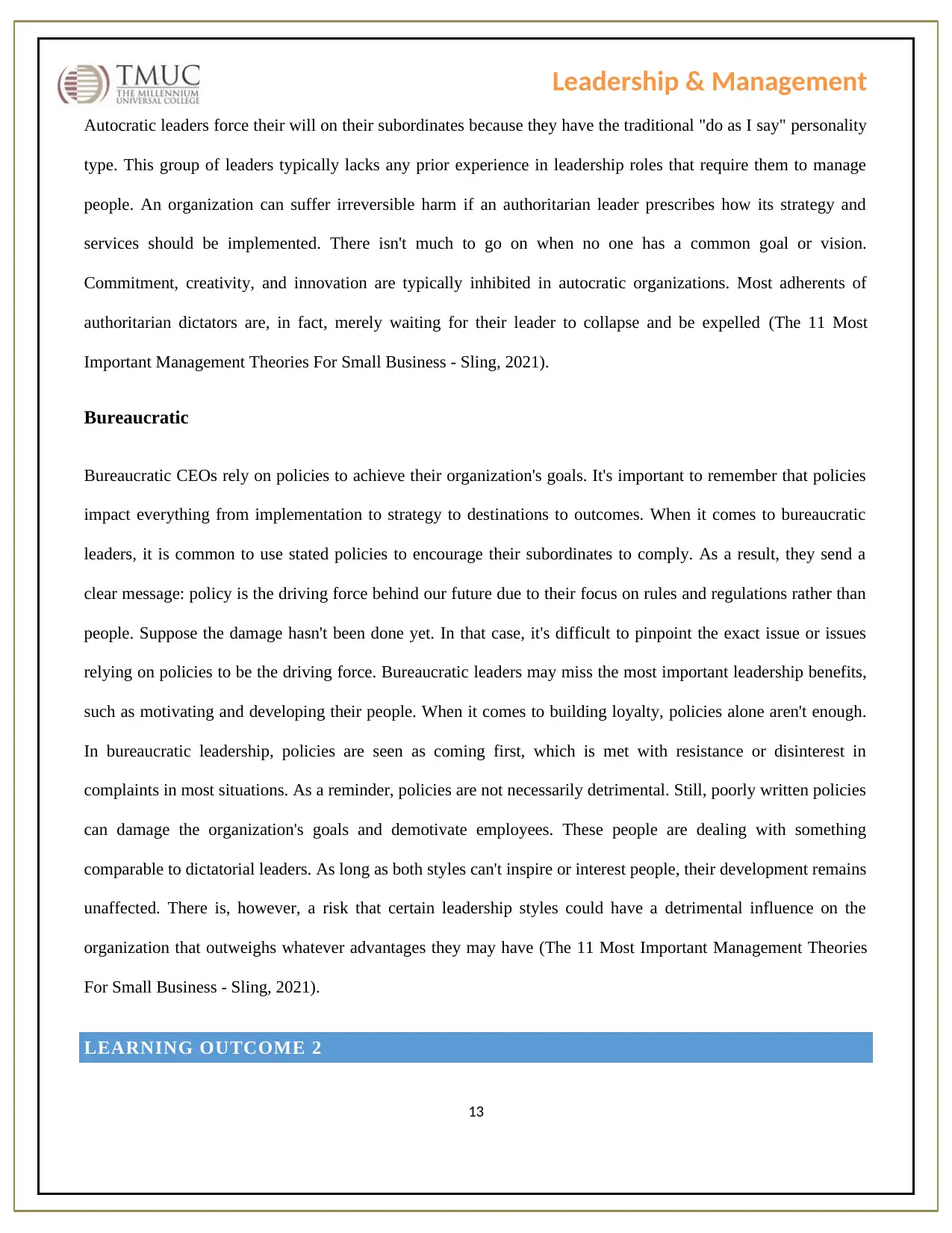
Leadership & Management
Autocratic leaders force their will on their subordinates because they have the traditional "do as I say" personality
type. This group of leaders typically lacks any prior experience in leadership roles that require them to manage
people. An organization can suffer irreversible harm if an authoritarian leader prescribes how its strategy and
services should be implemented. There isn't much to go on when no one has a common goal or vision.
Commitment, creativity, and innovation are typically inhibited in autocratic organizations. Most adherents of
authoritarian dictators are, in fact, merely waiting for their leader to collapse and be expelled (The 11 Most
Important Management Theories For Small Business - Sling, 2021).
Bureaucratic
Bureaucratic CEOs rely on policies to achieve their organization's goals. It's important to remember that policies
impact everything from implementation to strategy to destinations to outcomes. When it comes to bureaucratic
leaders, it is common to use stated policies to encourage their subordinates to comply. As a result, they send a
clear message: policy is the driving force behind our future due to their focus on rules and regulations rather than
people. Suppose the damage hasn't been done yet. In that case, it's difficult to pinpoint the exact issue or issues
relying on policies to be the driving force. Bureaucratic leaders may miss the most important leadership benefits,
such as motivating and developing their people. When it comes to building loyalty, policies alone aren't enough.
In bureaucratic leadership, policies are seen as coming first, which is met with resistance or disinterest in
complaints in most situations. As a reminder, policies are not necessarily detrimental. Still, poorly written policies
can damage the organization's goals and demotivate employees. These people are dealing with something
comparable to dictatorial leaders. As long as both styles can't inspire or interest people, their development remains
unaffected. There is, however, a risk that certain leadership styles could have a detrimental influence on the
organization that outweighs whatever advantages they may have (The 11 Most Important Management Theories
For Small Business - Sling, 2021).
LEARNING OUTCOME 2
13
Autocratic leaders force their will on their subordinates because they have the traditional "do as I say" personality
type. This group of leaders typically lacks any prior experience in leadership roles that require them to manage
people. An organization can suffer irreversible harm if an authoritarian leader prescribes how its strategy and
services should be implemented. There isn't much to go on when no one has a common goal or vision.
Commitment, creativity, and innovation are typically inhibited in autocratic organizations. Most adherents of
authoritarian dictators are, in fact, merely waiting for their leader to collapse and be expelled (The 11 Most
Important Management Theories For Small Business - Sling, 2021).
Bureaucratic
Bureaucratic CEOs rely on policies to achieve their organization's goals. It's important to remember that policies
impact everything from implementation to strategy to destinations to outcomes. When it comes to bureaucratic
leaders, it is common to use stated policies to encourage their subordinates to comply. As a result, they send a
clear message: policy is the driving force behind our future due to their focus on rules and regulations rather than
people. Suppose the damage hasn't been done yet. In that case, it's difficult to pinpoint the exact issue or issues
relying on policies to be the driving force. Bureaucratic leaders may miss the most important leadership benefits,
such as motivating and developing their people. When it comes to building loyalty, policies alone aren't enough.
In bureaucratic leadership, policies are seen as coming first, which is met with resistance or disinterest in
complaints in most situations. As a reminder, policies are not necessarily detrimental. Still, poorly written policies
can damage the organization's goals and demotivate employees. These people are dealing with something
comparable to dictatorial leaders. As long as both styles can't inspire or interest people, their development remains
unaffected. There is, however, a risk that certain leadership styles could have a detrimental influence on the
organization that outweighs whatever advantages they may have (The 11 Most Important Management Theories
For Small Business - Sling, 2021).
LEARNING OUTCOME 2
13
Paraphrase This Document
Need a fresh take? Get an instant paraphrase of this document with our AI Paraphraser
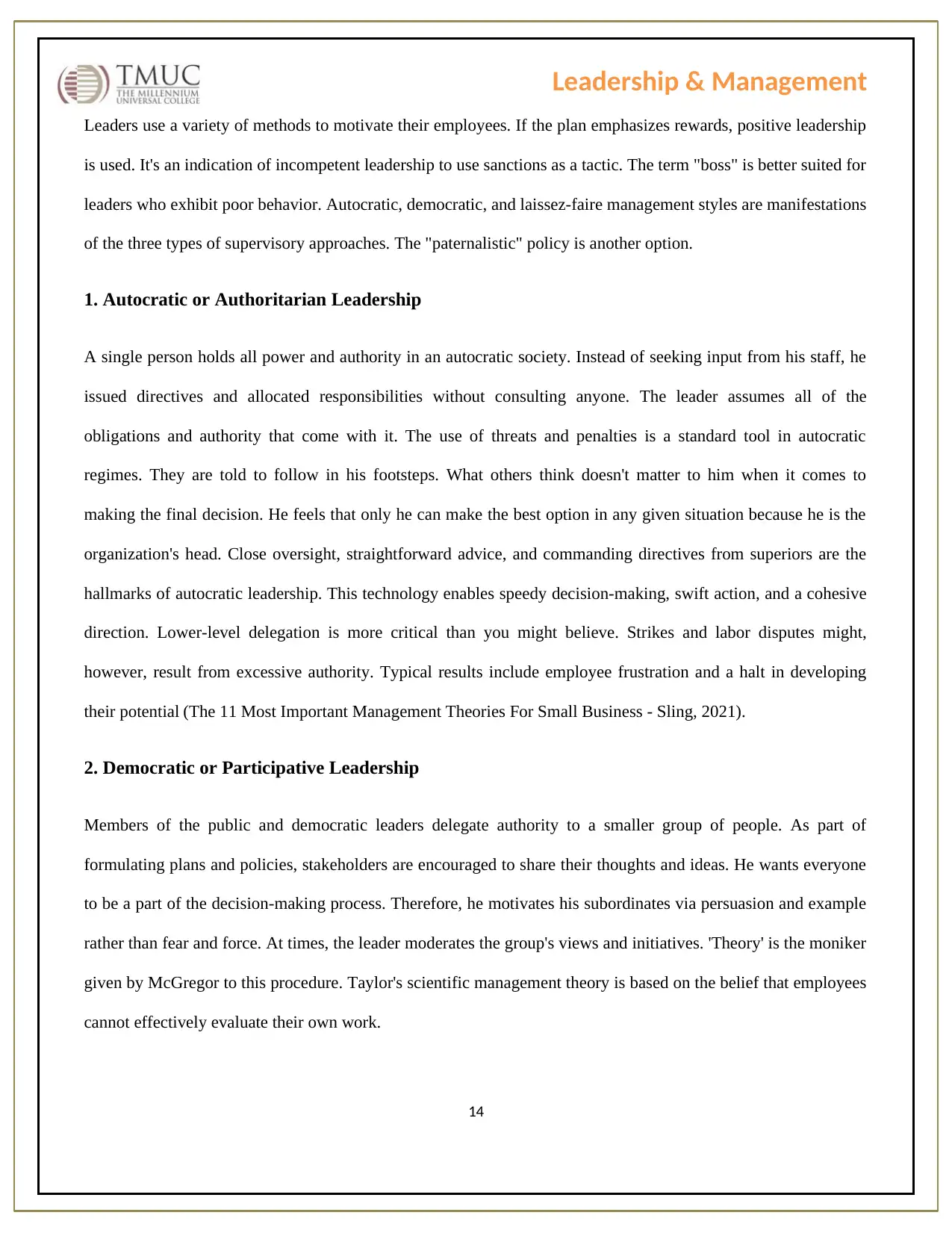
Leadership & Management
Leaders use a variety of methods to motivate their employees. If the plan emphasizes rewards, positive leadership
is used. It's an indication of incompetent leadership to use sanctions as a tactic. The term "boss" is better suited for
leaders who exhibit poor behavior. Autocratic, democratic, and laissez-faire management styles are manifestations
of the three types of supervisory approaches. The "paternalistic" policy is another option.
1. Autocratic or Authoritarian Leadership
A single person holds all power and authority in an autocratic society. Instead of seeking input from his staff, he
issued directives and allocated responsibilities without consulting anyone. The leader assumes all of the
obligations and authority that come with it. The use of threats and penalties is a standard tool in autocratic
regimes. They are told to follow in his footsteps. What others think doesn't matter to him when it comes to
making the final decision. He feels that only he can make the best option in any given situation because he is the
organization's head. Close oversight, straightforward advice, and commanding directives from superiors are the
hallmarks of autocratic leadership. This technology enables speedy decision-making, swift action, and a cohesive
direction. Lower-level delegation is more critical than you might believe. Strikes and labor disputes might,
however, result from excessive authority. Typical results include employee frustration and a halt in developing
their potential (The 11 Most Important Management Theories For Small Business - Sling, 2021).
2. Democratic or Participative Leadership
Members of the public and democratic leaders delegate authority to a smaller group of people. As part of
formulating plans and policies, stakeholders are encouraged to share their thoughts and ideas. He wants everyone
to be a part of the decision-making process. Therefore, he motivates his subordinates via persuasion and example
rather than fear and force. At times, the leader moderates the group's views and initiatives. 'Theory' is the moniker
given by McGregor to this procedure. Taylor's scientific management theory is based on the belief that employees
cannot effectively evaluate their own work.
14
Leaders use a variety of methods to motivate their employees. If the plan emphasizes rewards, positive leadership
is used. It's an indication of incompetent leadership to use sanctions as a tactic. The term "boss" is better suited for
leaders who exhibit poor behavior. Autocratic, democratic, and laissez-faire management styles are manifestations
of the three types of supervisory approaches. The "paternalistic" policy is another option.
1. Autocratic or Authoritarian Leadership
A single person holds all power and authority in an autocratic society. Instead of seeking input from his staff, he
issued directives and allocated responsibilities without consulting anyone. The leader assumes all of the
obligations and authority that come with it. The use of threats and penalties is a standard tool in autocratic
regimes. They are told to follow in his footsteps. What others think doesn't matter to him when it comes to
making the final decision. He feels that only he can make the best option in any given situation because he is the
organization's head. Close oversight, straightforward advice, and commanding directives from superiors are the
hallmarks of autocratic leadership. This technology enables speedy decision-making, swift action, and a cohesive
direction. Lower-level delegation is more critical than you might believe. Strikes and labor disputes might,
however, result from excessive authority. Typical results include employee frustration and a halt in developing
their potential (The 11 Most Important Management Theories For Small Business - Sling, 2021).
2. Democratic or Participative Leadership
Members of the public and democratic leaders delegate authority to a smaller group of people. As part of
formulating plans and policies, stakeholders are encouraged to share their thoughts and ideas. He wants everyone
to be a part of the decision-making process. Therefore, he motivates his subordinates via persuasion and example
rather than fear and force. At times, the leader moderates the group's views and initiatives. 'Theory' is the moniker
given by McGregor to this procedure. Taylor's scientific management theory is based on the belief that employees
cannot effectively evaluate their own work.
14
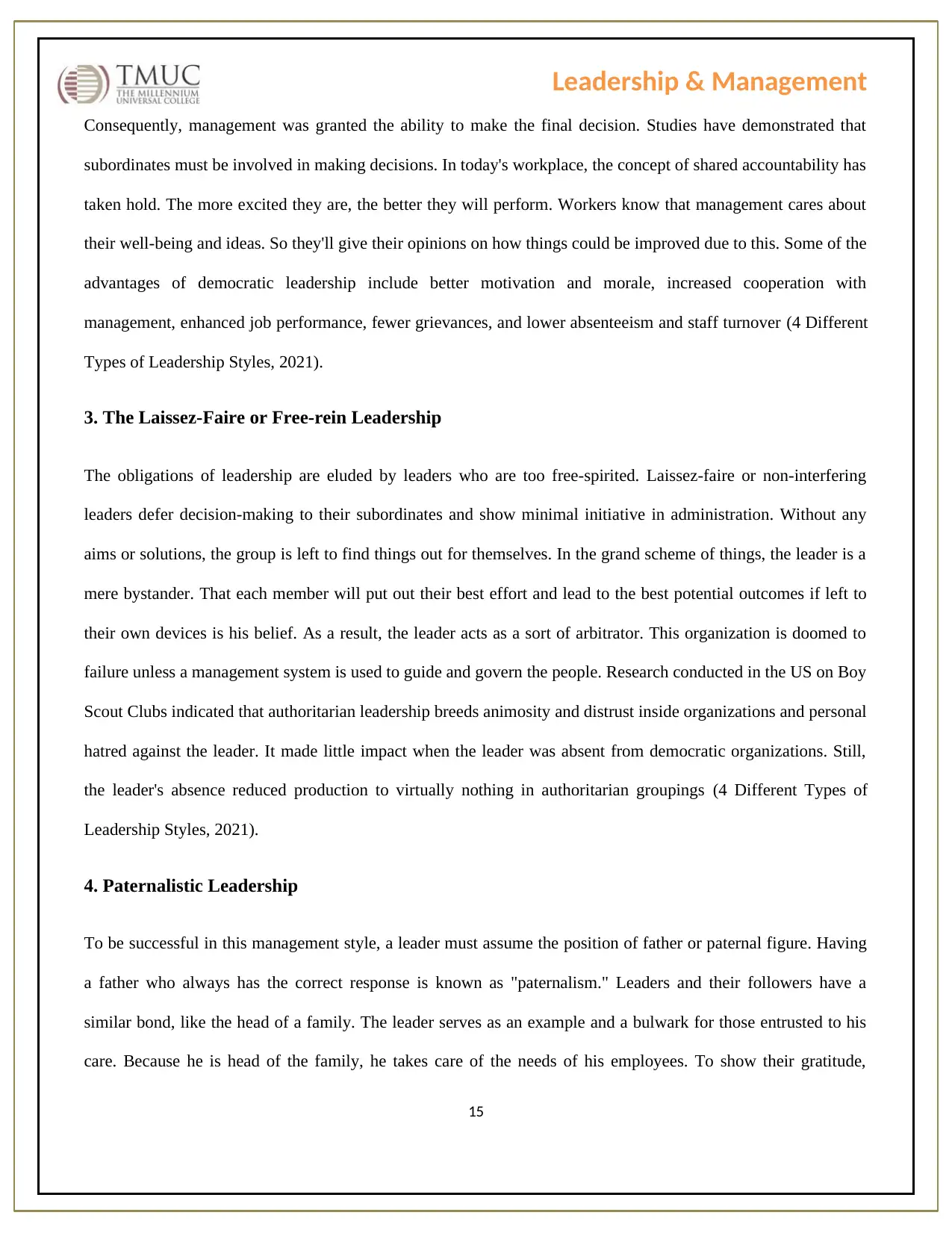
Leadership & Management
Consequently, management was granted the ability to make the final decision. Studies have demonstrated that
subordinates must be involved in making decisions. In today's workplace, the concept of shared accountability has
taken hold. The more excited they are, the better they will perform. Workers know that management cares about
their well-being and ideas. So they'll give their opinions on how things could be improved due to this. Some of the
advantages of democratic leadership include better motivation and morale, increased cooperation with
management, enhanced job performance, fewer grievances, and lower absenteeism and staff turnover (4 Different
Types of Leadership Styles, 2021).
3. The Laissez-Faire or Free-rein Leadership
The obligations of leadership are eluded by leaders who are too free-spirited. Laissez-faire or non-interfering
leaders defer decision-making to their subordinates and show minimal initiative in administration. Without any
aims or solutions, the group is left to find things out for themselves. In the grand scheme of things, the leader is a
mere bystander. That each member will put out their best effort and lead to the best potential outcomes if left to
their own devices is his belief. As a result, the leader acts as a sort of arbitrator. This organization is doomed to
failure unless a management system is used to guide and govern the people. Research conducted in the US on Boy
Scout Clubs indicated that authoritarian leadership breeds animosity and distrust inside organizations and personal
hatred against the leader. It made little impact when the leader was absent from democratic organizations. Still,
the leader's absence reduced production to virtually nothing in authoritarian groupings (4 Different Types of
Leadership Styles, 2021).
4. Paternalistic Leadership
To be successful in this management style, a leader must assume the position of father or paternal figure. Having
a father who always has the correct response is known as "paternalism." Leaders and their followers have a
similar bond, like the head of a family. The leader serves as an example and a bulwark for those entrusted to his
care. Because he is head of the family, he takes care of the needs of his employees. To show their gratitude,
15
Consequently, management was granted the ability to make the final decision. Studies have demonstrated that
subordinates must be involved in making decisions. In today's workplace, the concept of shared accountability has
taken hold. The more excited they are, the better they will perform. Workers know that management cares about
their well-being and ideas. So they'll give their opinions on how things could be improved due to this. Some of the
advantages of democratic leadership include better motivation and morale, increased cooperation with
management, enhanced job performance, fewer grievances, and lower absenteeism and staff turnover (4 Different
Types of Leadership Styles, 2021).
3. The Laissez-Faire or Free-rein Leadership
The obligations of leadership are eluded by leaders who are too free-spirited. Laissez-faire or non-interfering
leaders defer decision-making to their subordinates and show minimal initiative in administration. Without any
aims or solutions, the group is left to find things out for themselves. In the grand scheme of things, the leader is a
mere bystander. That each member will put out their best effort and lead to the best potential outcomes if left to
their own devices is his belief. As a result, the leader acts as a sort of arbitrator. This organization is doomed to
failure unless a management system is used to guide and govern the people. Research conducted in the US on Boy
Scout Clubs indicated that authoritarian leadership breeds animosity and distrust inside organizations and personal
hatred against the leader. It made little impact when the leader was absent from democratic organizations. Still,
the leader's absence reduced production to virtually nothing in authoritarian groupings (4 Different Types of
Leadership Styles, 2021).
4. Paternalistic Leadership
To be successful in this management style, a leader must assume the position of father or paternal figure. Having
a father who always has the correct response is known as "paternalism." Leaders and their followers have a
similar bond, like the head of a family. The leader serves as an example and a bulwark for those entrusted to his
care. Because he is head of the family, he takes care of the needs of his employees. To show their gratitude,
15
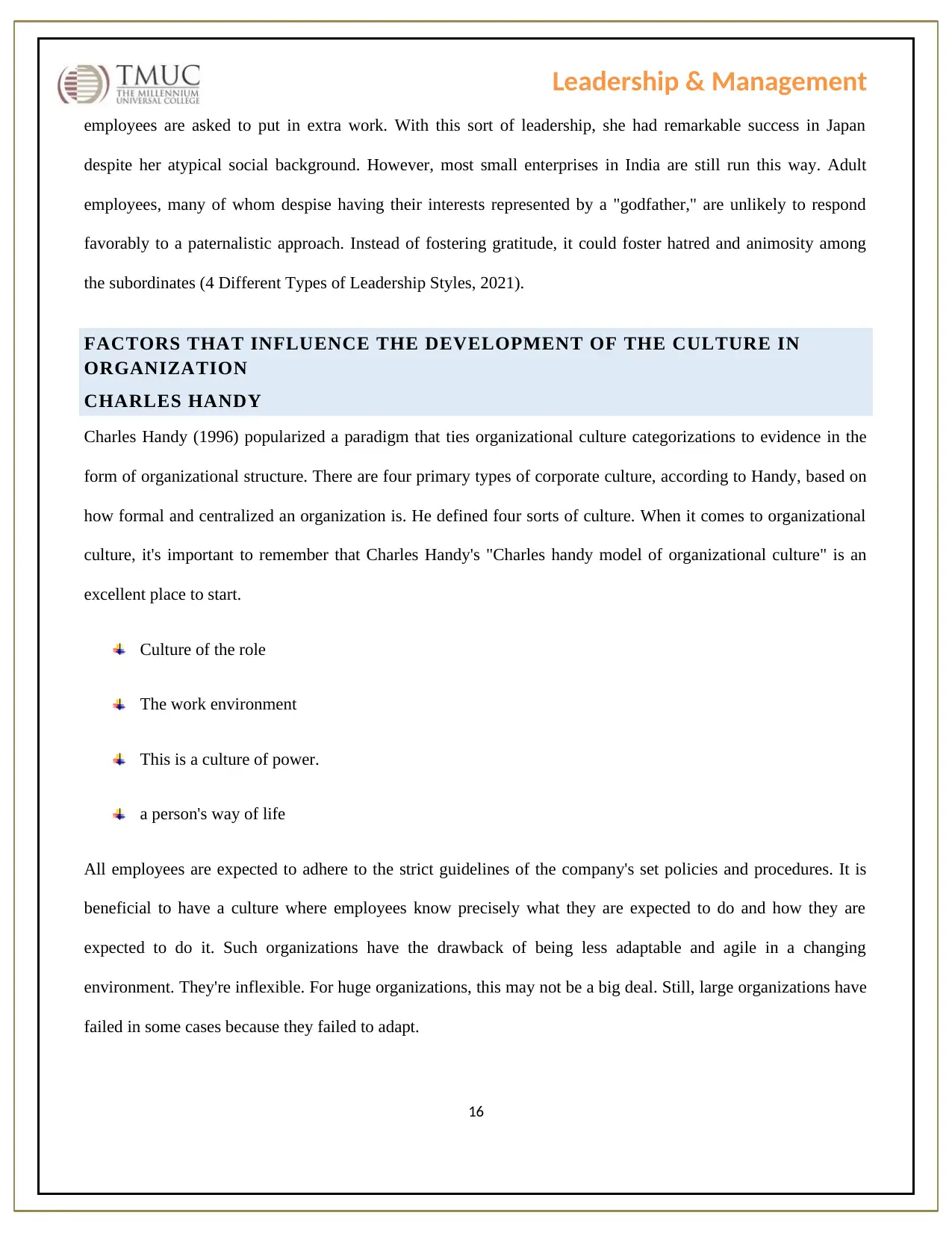
Leadership & Management
employees are asked to put in extra work. With this sort of leadership, she had remarkable success in Japan
despite her atypical social background. However, most small enterprises in India are still run this way. Adult
employees, many of whom despise having their interests represented by a "godfather," are unlikely to respond
favorably to a paternalistic approach. Instead of fostering gratitude, it could foster hatred and animosity among
the subordinates (4 Different Types of Leadership Styles, 2021).
FACTORS THAT INFLUENCE THE DEVELOPMENT OF THE CULTURE IN
ORGANIZATION
CHARLES HANDY
Charles Handy (1996) popularized a paradigm that ties organizational culture categorizations to evidence in the
form of organizational structure. There are four primary types of corporate culture, according to Handy, based on
how formal and centralized an organization is. He defined four sorts of culture. When it comes to organizational
culture, it's important to remember that Charles Handy's "Charles handy model of organizational culture" is an
excellent place to start.
Culture of the role
The work environment
This is a culture of power.
a person's way of life
All employees are expected to adhere to the strict guidelines of the company's set policies and procedures. It is
beneficial to have a culture where employees know precisely what they are expected to do and how they are
expected to do it. Such organizations have the drawback of being less adaptable and agile in a changing
environment. They're inflexible. For huge organizations, this may not be a big deal. Still, large organizations have
failed in some cases because they failed to adapt.
16
employees are asked to put in extra work. With this sort of leadership, she had remarkable success in Japan
despite her atypical social background. However, most small enterprises in India are still run this way. Adult
employees, many of whom despise having their interests represented by a "godfather," are unlikely to respond
favorably to a paternalistic approach. Instead of fostering gratitude, it could foster hatred and animosity among
the subordinates (4 Different Types of Leadership Styles, 2021).
FACTORS THAT INFLUENCE THE DEVELOPMENT OF THE CULTURE IN
ORGANIZATION
CHARLES HANDY
Charles Handy (1996) popularized a paradigm that ties organizational culture categorizations to evidence in the
form of organizational structure. There are four primary types of corporate culture, according to Handy, based on
how formal and centralized an organization is. He defined four sorts of culture. When it comes to organizational
culture, it's important to remember that Charles Handy's "Charles handy model of organizational culture" is an
excellent place to start.
Culture of the role
The work environment
This is a culture of power.
a person's way of life
All employees are expected to adhere to the strict guidelines of the company's set policies and procedures. It is
beneficial to have a culture where employees know precisely what they are expected to do and how they are
expected to do it. Such organizations have the drawback of being less adaptable and agile in a changing
environment. They're inflexible. For huge organizations, this may not be a big deal. Still, large organizations have
failed in some cases because they failed to adapt.
16
Secure Best Marks with AI Grader
Need help grading? Try our AI Grader for instant feedback on your assignments.
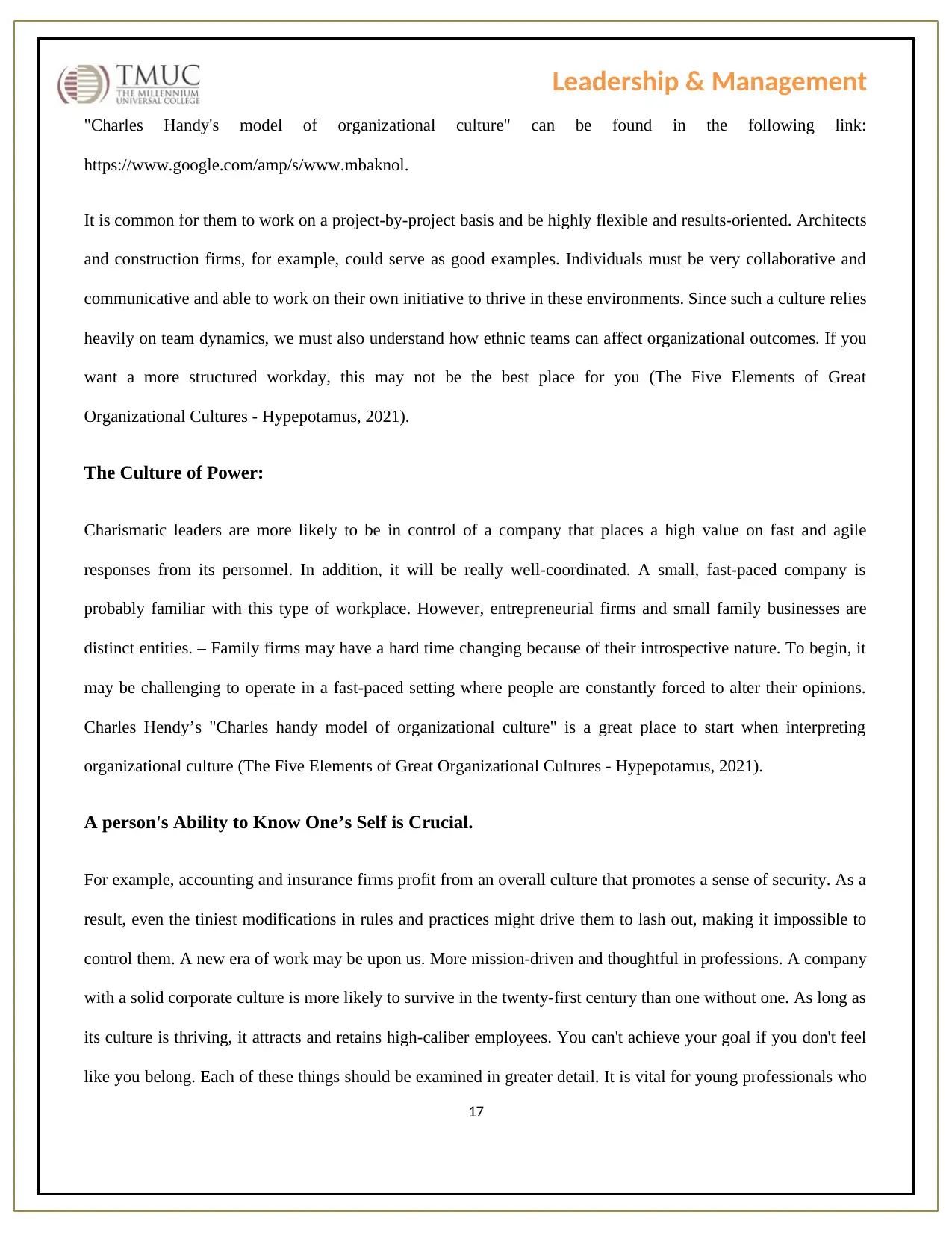
Leadership & Management
"Charles Handy's model of organizational culture" can be found in the following link:
https://www.google.com/amp/s/www.mbaknol.
It is common for them to work on a project-by-project basis and be highly flexible and results-oriented. Architects
and construction firms, for example, could serve as good examples. Individuals must be very collaborative and
communicative and able to work on their own initiative to thrive in these environments. Since such a culture relies
heavily on team dynamics, we must also understand how ethnic teams can affect organizational outcomes. If you
want a more structured workday, this may not be the best place for you (The Five Elements of Great
Organizational Cultures - Hypepotamus, 2021).
The Culture of Power:
Charismatic leaders are more likely to be in control of a company that places a high value on fast and agile
responses from its personnel. In addition, it will be really well-coordinated. A small, fast-paced company is
probably familiar with this type of workplace. However, entrepreneurial firms and small family businesses are
distinct entities. – Family firms may have a hard time changing because of their introspective nature. To begin, it
may be challenging to operate in a fast-paced setting where people are constantly forced to alter their opinions.
Charles Hendy’s "Charles handy model of organizational culture" is a great place to start when interpreting
organizational culture (The Five Elements of Great Organizational Cultures - Hypepotamus, 2021).
A person's Ability to Know One’s Self is Crucial.
For example, accounting and insurance firms profit from an overall culture that promotes a sense of security. As a
result, even the tiniest modifications in rules and practices might drive them to lash out, making it impossible to
control them. A new era of work may be upon us. More mission-driven and thoughtful in professions. A company
with a solid corporate culture is more likely to survive in the twenty-first century than one without one. As long as
its culture is thriving, it attracts and retains high-caliber employees. You can't achieve your goal if you don't feel
like you belong. Each of these things should be examined in greater detail. It is vital for young professionals who
17
"Charles Handy's model of organizational culture" can be found in the following link:
https://www.google.com/amp/s/www.mbaknol.
It is common for them to work on a project-by-project basis and be highly flexible and results-oriented. Architects
and construction firms, for example, could serve as good examples. Individuals must be very collaborative and
communicative and able to work on their own initiative to thrive in these environments. Since such a culture relies
heavily on team dynamics, we must also understand how ethnic teams can affect organizational outcomes. If you
want a more structured workday, this may not be the best place for you (The Five Elements of Great
Organizational Cultures - Hypepotamus, 2021).
The Culture of Power:
Charismatic leaders are more likely to be in control of a company that places a high value on fast and agile
responses from its personnel. In addition, it will be really well-coordinated. A small, fast-paced company is
probably familiar with this type of workplace. However, entrepreneurial firms and small family businesses are
distinct entities. – Family firms may have a hard time changing because of their introspective nature. To begin, it
may be challenging to operate in a fast-paced setting where people are constantly forced to alter their opinions.
Charles Hendy’s "Charles handy model of organizational culture" is a great place to start when interpreting
organizational culture (The Five Elements of Great Organizational Cultures - Hypepotamus, 2021).
A person's Ability to Know One’s Self is Crucial.
For example, accounting and insurance firms profit from an overall culture that promotes a sense of security. As a
result, even the tiniest modifications in rules and practices might drive them to lash out, making it impossible to
control them. A new era of work may be upon us. More mission-driven and thoughtful in professions. A company
with a solid corporate culture is more likely to survive in the twenty-first century than one without one. As long as
its culture is thriving, it attracts and retains high-caliber employees. You can't achieve your goal if you don't feel
like you belong. Each of these things should be examined in greater detail. It is vital for young professionals who
17
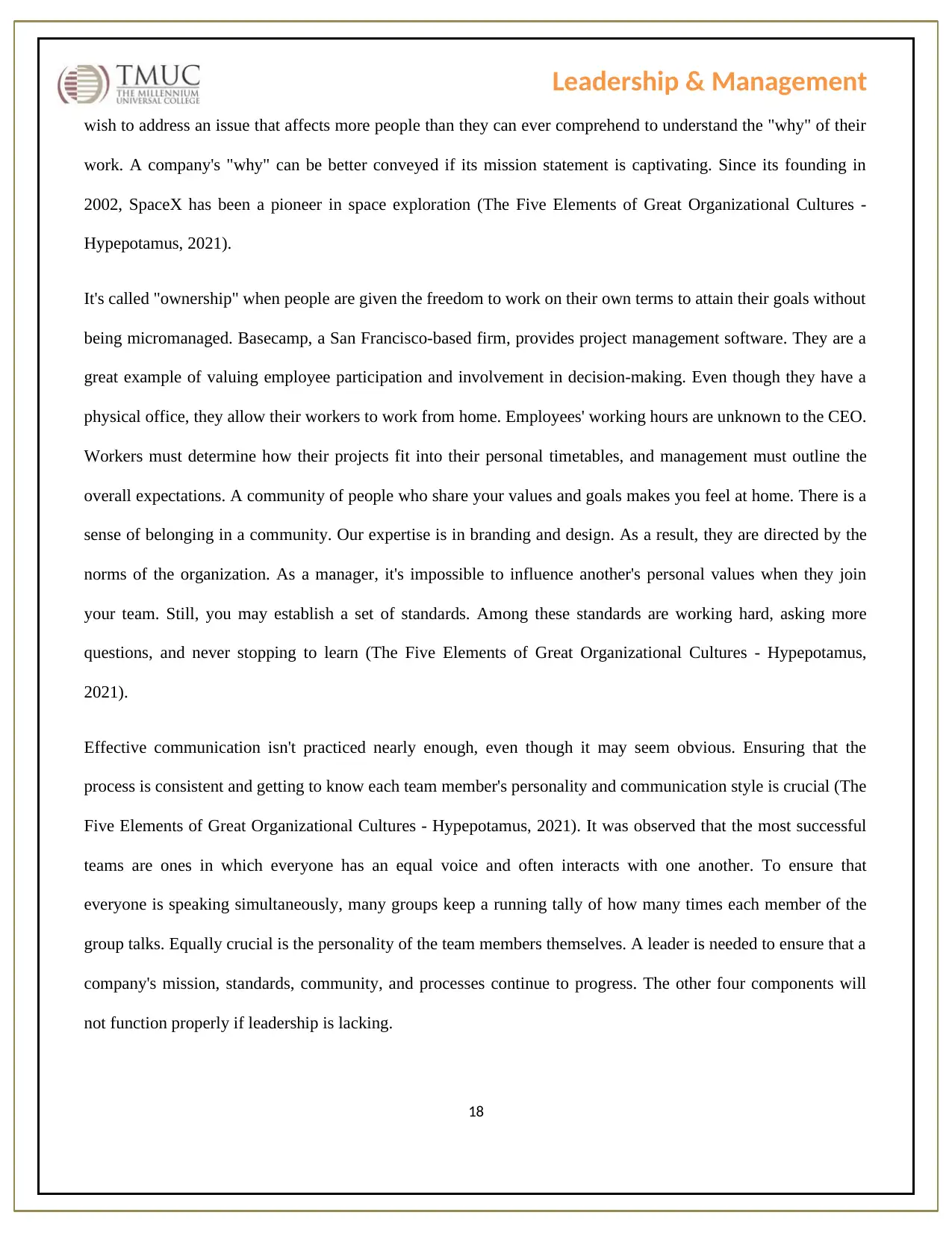
Leadership & Management
wish to address an issue that affects more people than they can ever comprehend to understand the "why" of their
work. A company's "why" can be better conveyed if its mission statement is captivating. Since its founding in
2002, SpaceX has been a pioneer in space exploration (The Five Elements of Great Organizational Cultures -
Hypepotamus, 2021).
It's called "ownership" when people are given the freedom to work on their own terms to attain their goals without
being micromanaged. Basecamp, a San Francisco-based firm, provides project management software. They are a
great example of valuing employee participation and involvement in decision-making. Even though they have a
physical office, they allow their workers to work from home. Employees' working hours are unknown to the CEO.
Workers must determine how their projects fit into their personal timetables, and management must outline the
overall expectations. A community of people who share your values and goals makes you feel at home. There is a
sense of belonging in a community. Our expertise is in branding and design. As a result, they are directed by the
norms of the organization. As a manager, it's impossible to influence another's personal values when they join
your team. Still, you may establish a set of standards. Among these standards are working hard, asking more
questions, and never stopping to learn (The Five Elements of Great Organizational Cultures - Hypepotamus,
2021).
Effective communication isn't practiced nearly enough, even though it may seem obvious. Ensuring that the
process is consistent and getting to know each team member's personality and communication style is crucial (The
Five Elements of Great Organizational Cultures - Hypepotamus, 2021). It was observed that the most successful
teams are ones in which everyone has an equal voice and often interacts with one another. To ensure that
everyone is speaking simultaneously, many groups keep a running tally of how many times each member of the
group talks. Equally crucial is the personality of the team members themselves. A leader is needed to ensure that a
company's mission, standards, community, and processes continue to progress. The other four components will
not function properly if leadership is lacking.
18
wish to address an issue that affects more people than they can ever comprehend to understand the "why" of their
work. A company's "why" can be better conveyed if its mission statement is captivating. Since its founding in
2002, SpaceX has been a pioneer in space exploration (The Five Elements of Great Organizational Cultures -
Hypepotamus, 2021).
It's called "ownership" when people are given the freedom to work on their own terms to attain their goals without
being micromanaged. Basecamp, a San Francisco-based firm, provides project management software. They are a
great example of valuing employee participation and involvement in decision-making. Even though they have a
physical office, they allow their workers to work from home. Employees' working hours are unknown to the CEO.
Workers must determine how their projects fit into their personal timetables, and management must outline the
overall expectations. A community of people who share your values and goals makes you feel at home. There is a
sense of belonging in a community. Our expertise is in branding and design. As a result, they are directed by the
norms of the organization. As a manager, it's impossible to influence another's personal values when they join
your team. Still, you may establish a set of standards. Among these standards are working hard, asking more
questions, and never stopping to learn (The Five Elements of Great Organizational Cultures - Hypepotamus,
2021).
Effective communication isn't practiced nearly enough, even though it may seem obvious. Ensuring that the
process is consistent and getting to know each team member's personality and communication style is crucial (The
Five Elements of Great Organizational Cultures - Hypepotamus, 2021). It was observed that the most successful
teams are ones in which everyone has an equal voice and often interacts with one another. To ensure that
everyone is speaking simultaneously, many groups keep a running tally of how many times each member of the
group talks. Equally crucial is the personality of the team members themselves. A leader is needed to ensure that a
company's mission, standards, community, and processes continue to progress. The other four components will
not function properly if leadership is lacking.
18
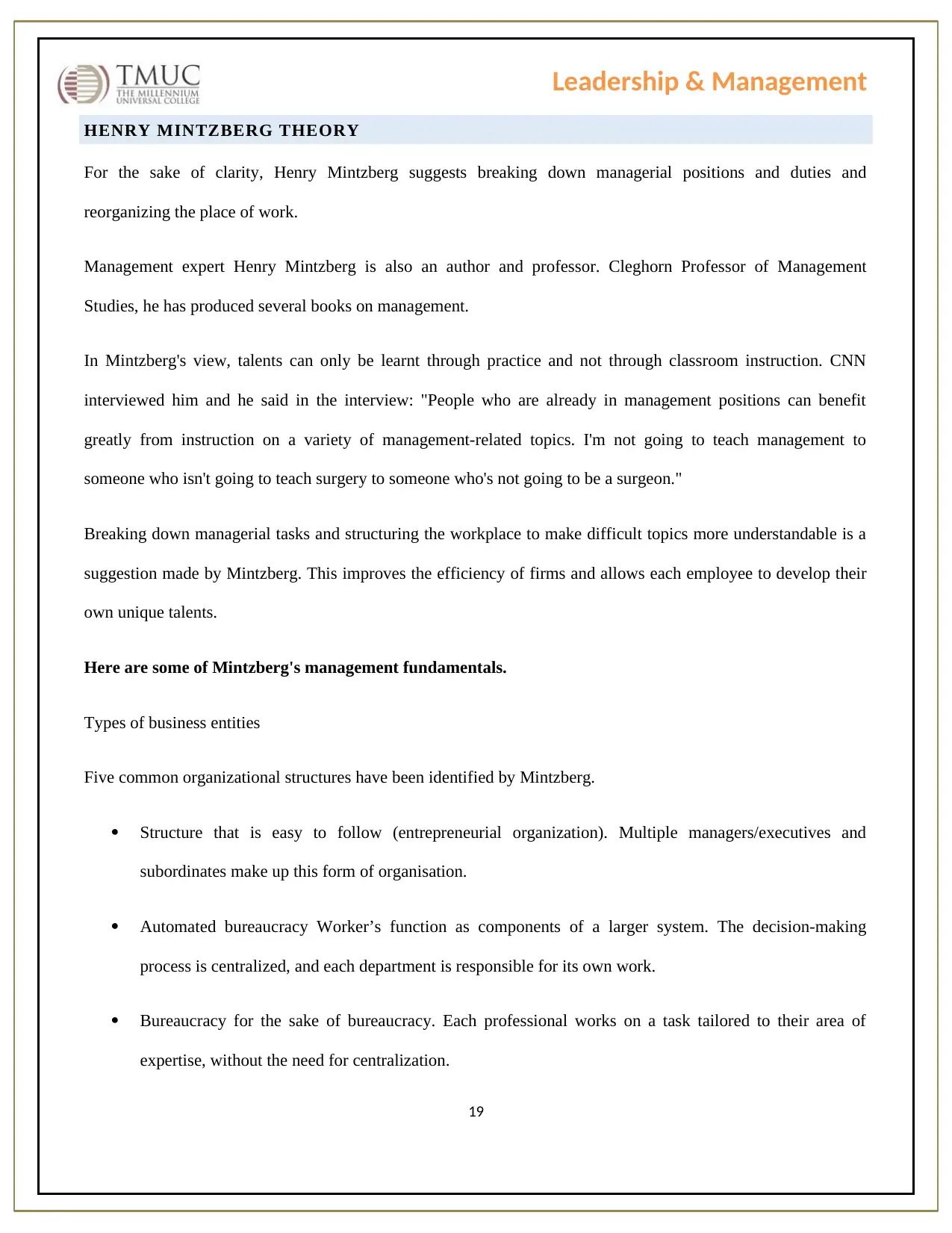
Leadership & Management
HENRY MINTZBERG THEORY
For the sake of clarity, Henry Mintzberg suggests breaking down managerial positions and duties and
reorganizing the place of work.
Management expert Henry Mintzberg is also an author and professor. Cleghorn Professor of Management
Studies, he has produced several books on management.
In Mintzberg's view, talents can only be learnt through practice and not through classroom instruction. CNN
interviewed him and he said in the interview: "People who are already in management positions can benefit
greatly from instruction on a variety of management-related topics. I'm not going to teach management to
someone who isn't going to teach surgery to someone who's not going to be a surgeon."
Breaking down managerial tasks and structuring the workplace to make difficult topics more understandable is a
suggestion made by Mintzberg. This improves the efficiency of firms and allows each employee to develop their
own unique talents.
Here are some of Mintzberg's management fundamentals.
Types of business entities
Five common organizational structures have been identified by Mintzberg.
Structure that is easy to follow (entrepreneurial organization). Multiple managers/executives and
subordinates make up this form of organisation.
Automated bureaucracy Worker’s function as components of a larger system. The decision-making
process is centralized, and each department is responsible for its own work.
Bureaucracy for the sake of bureaucracy. Each professional works on a task tailored to their area of
expertise, without the need for centralization.
19
HENRY MINTZBERG THEORY
For the sake of clarity, Henry Mintzberg suggests breaking down managerial positions and duties and
reorganizing the place of work.
Management expert Henry Mintzberg is also an author and professor. Cleghorn Professor of Management
Studies, he has produced several books on management.
In Mintzberg's view, talents can only be learnt through practice and not through classroom instruction. CNN
interviewed him and he said in the interview: "People who are already in management positions can benefit
greatly from instruction on a variety of management-related topics. I'm not going to teach management to
someone who isn't going to teach surgery to someone who's not going to be a surgeon."
Breaking down managerial tasks and structuring the workplace to make difficult topics more understandable is a
suggestion made by Mintzberg. This improves the efficiency of firms and allows each employee to develop their
own unique talents.
Here are some of Mintzberg's management fundamentals.
Types of business entities
Five common organizational structures have been identified by Mintzberg.
Structure that is easy to follow (entrepreneurial organization). Multiple managers/executives and
subordinates make up this form of organisation.
Automated bureaucracy Worker’s function as components of a larger system. The decision-making
process is centralized, and each department is responsible for its own work.
Bureaucracy for the sake of bureaucracy. Each professional works on a task tailored to their area of
expertise, without the need for centralization.
19
Paraphrase This Document
Need a fresh take? Get an instant paraphrase of this document with our AI Paraphraser
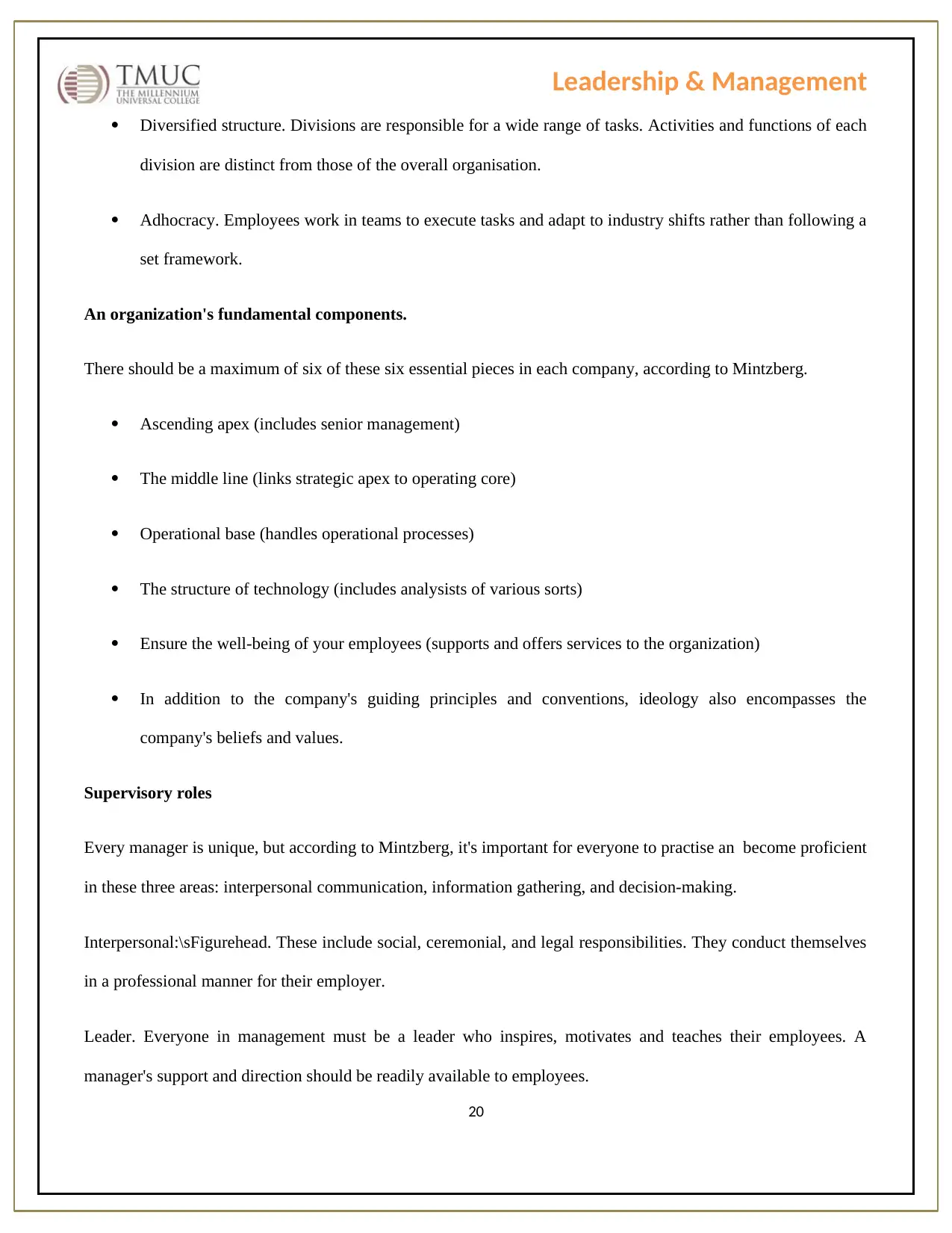
Leadership & Management
Diversified structure. Divisions are responsible for a wide range of tasks. Activities and functions of each
division are distinct from those of the overall organisation.
Adhocracy. Employees work in teams to execute tasks and adapt to industry shifts rather than following a
set framework.
An organization's fundamental components.
There should be a maximum of six of these six essential pieces in each company, according to Mintzberg.
Ascending apex (includes senior management)
The middle line (links strategic apex to operating core)
Operational base (handles operational processes)
The structure of technology (includes analysists of various sorts)
Ensure the well-being of your employees (supports and offers services to the organization)
In addition to the company's guiding principles and conventions, ideology also encompasses the
company's beliefs and values.
Supervisory roles
Every manager is unique, but according to Mintzberg, it's important for everyone to practise an become proficient
in these three areas: interpersonal communication, information gathering, and decision-making.
Interpersonal:\sFigurehead. These include social, ceremonial, and legal responsibilities. They conduct themselves
in a professional manner for their employer.
Leader. Everyone in management must be a leader who inspires, motivates and teaches their employees. A
manager's support and direction should be readily available to employees.
20
Diversified structure. Divisions are responsible for a wide range of tasks. Activities and functions of each
division are distinct from those of the overall organisation.
Adhocracy. Employees work in teams to execute tasks and adapt to industry shifts rather than following a
set framework.
An organization's fundamental components.
There should be a maximum of six of these six essential pieces in each company, according to Mintzberg.
Ascending apex (includes senior management)
The middle line (links strategic apex to operating core)
Operational base (handles operational processes)
The structure of technology (includes analysists of various sorts)
Ensure the well-being of your employees (supports and offers services to the organization)
In addition to the company's guiding principles and conventions, ideology also encompasses the
company's beliefs and values.
Supervisory roles
Every manager is unique, but according to Mintzberg, it's important for everyone to practise an become proficient
in these three areas: interpersonal communication, information gathering, and decision-making.
Interpersonal:\sFigurehead. These include social, ceremonial, and legal responsibilities. They conduct themselves
in a professional manner for their employer.
Leader. Everyone in management must be a leader who inspires, motivates and teaches their employees. A
manager's support and direction should be readily available to employees.
20
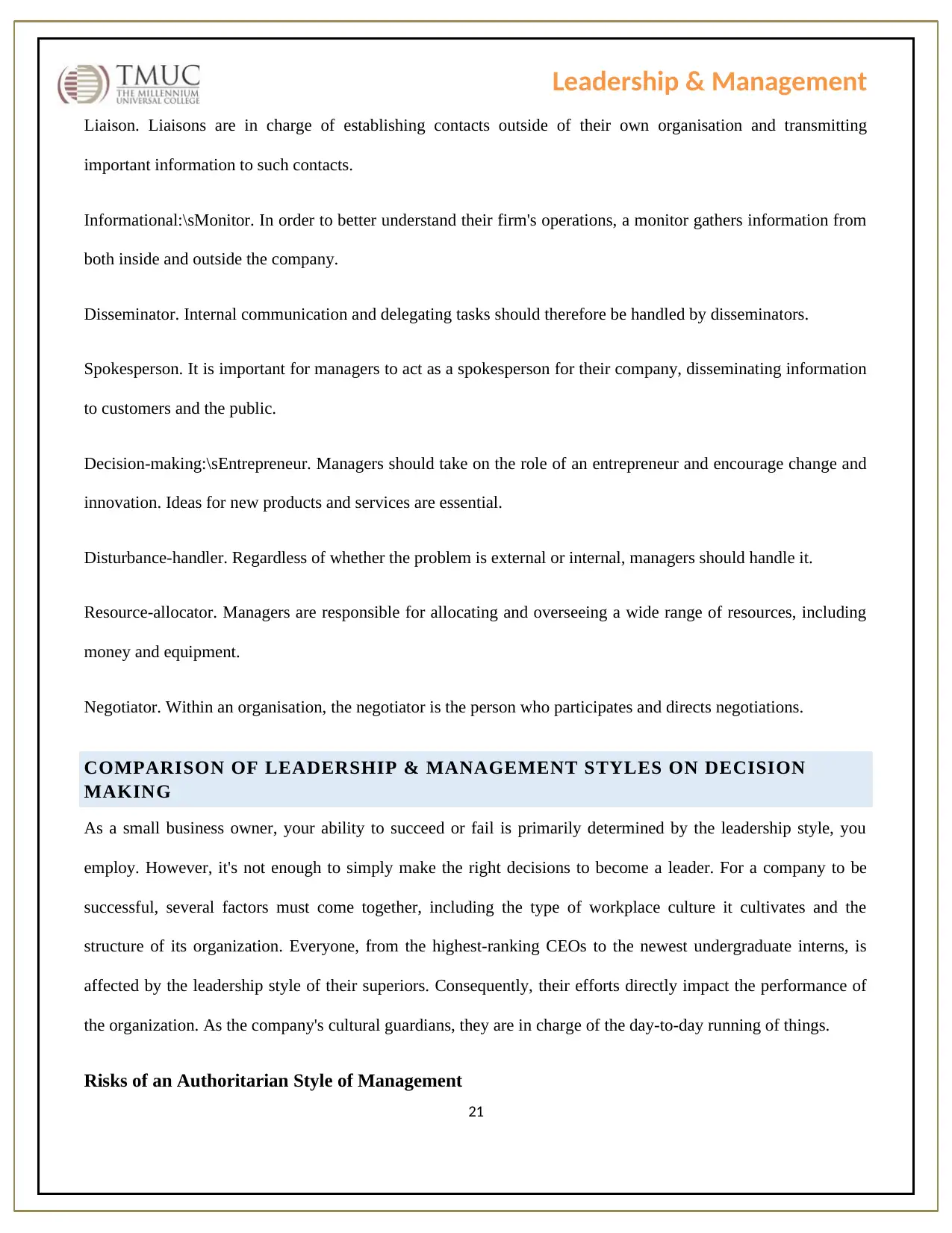
Leadership & Management
Liaison. Liaisons are in charge of establishing contacts outside of their own organisation and transmitting
important information to such contacts.
Informational:\sMonitor. In order to better understand their firm's operations, a monitor gathers information from
both inside and outside the company.
Disseminator. Internal communication and delegating tasks should therefore be handled by disseminators.
Spokesperson. It is important for managers to act as a spokesperson for their company, disseminating information
to customers and the public.
Decision-making:\sEntrepreneur. Managers should take on the role of an entrepreneur and encourage change and
innovation. Ideas for new products and services are essential.
Disturbance-handler. Regardless of whether the problem is external or internal, managers should handle it.
Resource-allocator. Managers are responsible for allocating and overseeing a wide range of resources, including
money and equipment.
Negotiator. Within an organisation, the negotiator is the person who participates and directs negotiations.
COMPARISON OF LEADERSHIP & MANAGEMENT STYLES ON DECISION
MAKING
As a small business owner, your ability to succeed or fail is primarily determined by the leadership style, you
employ. However, it's not enough to simply make the right decisions to become a leader. For a company to be
successful, several factors must come together, including the type of workplace culture it cultivates and the
structure of its organization. Everyone, from the highest-ranking CEOs to the newest undergraduate interns, is
affected by the leadership style of their superiors. Consequently, their efforts directly impact the performance of
the organization. As the company's cultural guardians, they are in charge of the day-to-day running of things.
Risks of an Authoritarian Style of Management
21
Liaison. Liaisons are in charge of establishing contacts outside of their own organisation and transmitting
important information to such contacts.
Informational:\sMonitor. In order to better understand their firm's operations, a monitor gathers information from
both inside and outside the company.
Disseminator. Internal communication and delegating tasks should therefore be handled by disseminators.
Spokesperson. It is important for managers to act as a spokesperson for their company, disseminating information
to customers and the public.
Decision-making:\sEntrepreneur. Managers should take on the role of an entrepreneur and encourage change and
innovation. Ideas for new products and services are essential.
Disturbance-handler. Regardless of whether the problem is external or internal, managers should handle it.
Resource-allocator. Managers are responsible for allocating and overseeing a wide range of resources, including
money and equipment.
Negotiator. Within an organisation, the negotiator is the person who participates and directs negotiations.
COMPARISON OF LEADERSHIP & MANAGEMENT STYLES ON DECISION
MAKING
As a small business owner, your ability to succeed or fail is primarily determined by the leadership style, you
employ. However, it's not enough to simply make the right decisions to become a leader. For a company to be
successful, several factors must come together, including the type of workplace culture it cultivates and the
structure of its organization. Everyone, from the highest-ranking CEOs to the newest undergraduate interns, is
affected by the leadership style of their superiors. Consequently, their efforts directly impact the performance of
the organization. As the company's cultural guardians, they are in charge of the day-to-day running of things.
Risks of an Authoritarian Style of Management
21
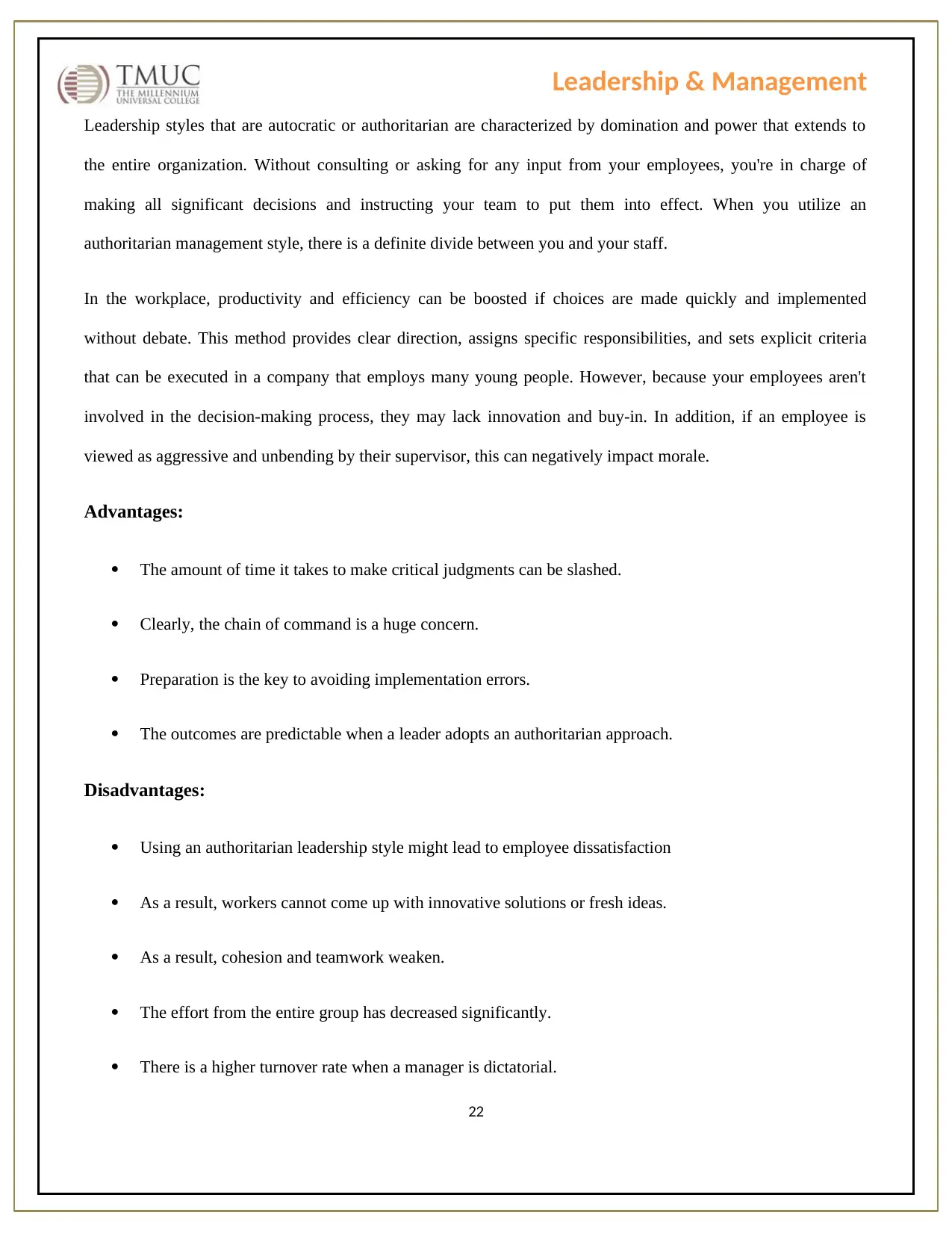
Leadership & Management
Leadership styles that are autocratic or authoritarian are characterized by domination and power that extends to
the entire organization. Without consulting or asking for any input from your employees, you're in charge of
making all significant decisions and instructing your team to put them into effect. When you utilize an
authoritarian management style, there is a definite divide between you and your staff.
In the workplace, productivity and efficiency can be boosted if choices are made quickly and implemented
without debate. This method provides clear direction, assigns specific responsibilities, and sets explicit criteria
that can be executed in a company that employs many young people. However, because your employees aren't
involved in the decision-making process, they may lack innovation and buy-in. In addition, if an employee is
viewed as aggressive and unbending by their supervisor, this can negatively impact morale.
Advantages:
The amount of time it takes to make critical judgments can be slashed.
Clearly, the chain of command is a huge concern.
Preparation is the key to avoiding implementation errors.
The outcomes are predictable when a leader adopts an authoritarian approach.
Disadvantages:
Using an authoritarian leadership style might lead to employee dissatisfaction
As a result, workers cannot come up with innovative solutions or fresh ideas.
As a result, cohesion and teamwork weaken.
The effort from the entire group has decreased significantly.
There is a higher turnover rate when a manager is dictatorial.
22
Leadership styles that are autocratic or authoritarian are characterized by domination and power that extends to
the entire organization. Without consulting or asking for any input from your employees, you're in charge of
making all significant decisions and instructing your team to put them into effect. When you utilize an
authoritarian management style, there is a definite divide between you and your staff.
In the workplace, productivity and efficiency can be boosted if choices are made quickly and implemented
without debate. This method provides clear direction, assigns specific responsibilities, and sets explicit criteria
that can be executed in a company that employs many young people. However, because your employees aren't
involved in the decision-making process, they may lack innovation and buy-in. In addition, if an employee is
viewed as aggressive and unbending by their supervisor, this can negatively impact morale.
Advantages:
The amount of time it takes to make critical judgments can be slashed.
Clearly, the chain of command is a huge concern.
Preparation is the key to avoiding implementation errors.
The outcomes are predictable when a leader adopts an authoritarian approach.
Disadvantages:
Using an authoritarian leadership style might lead to employee dissatisfaction
As a result, workers cannot come up with innovative solutions or fresh ideas.
As a result, cohesion and teamwork weaken.
The effort from the entire group has decreased significantly.
There is a higher turnover rate when a manager is dictatorial.
22
Secure Best Marks with AI Grader
Need help grading? Try our AI Grader for instant feedback on your assignments.
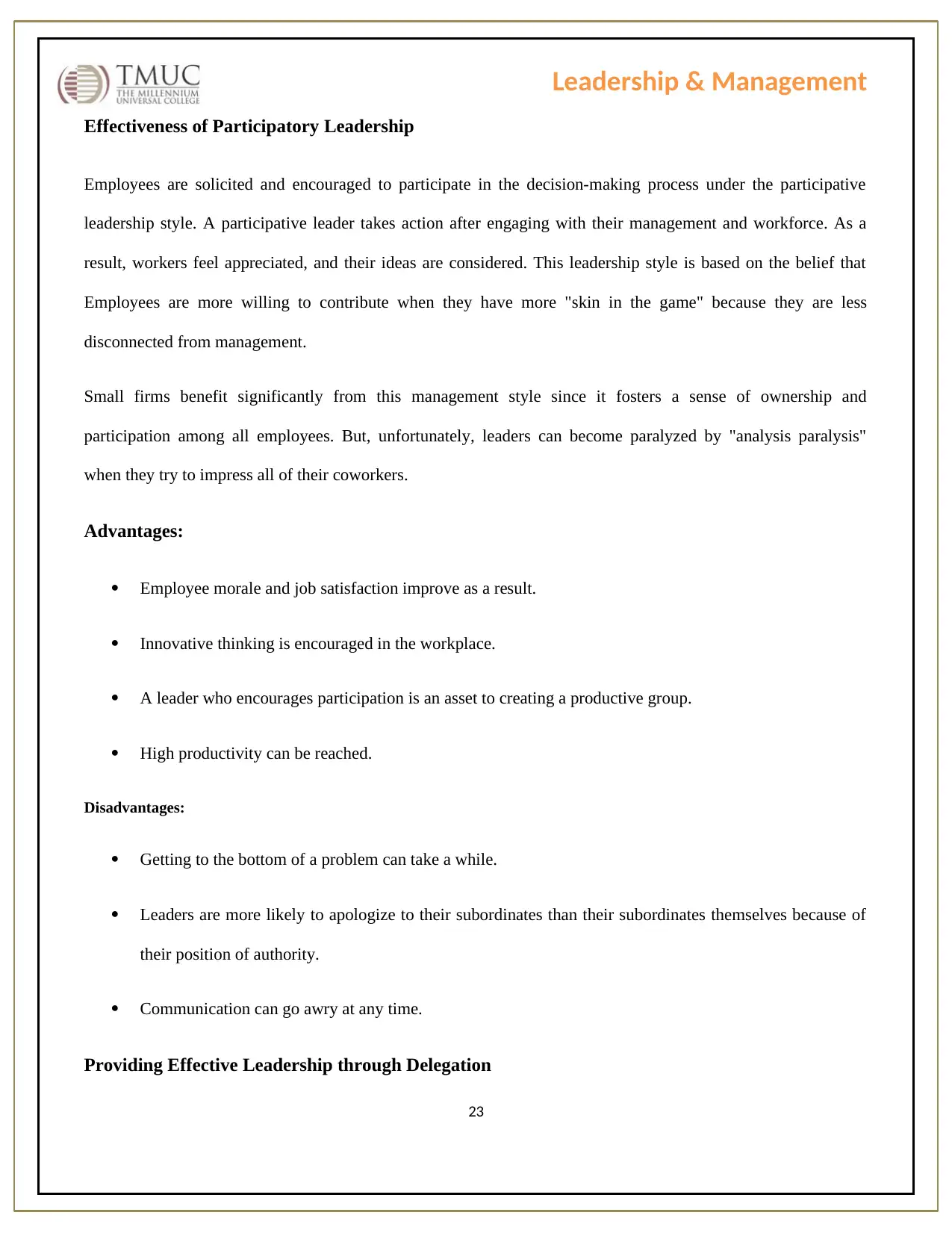
Leadership & Management
Effectiveness of Participatory Leadership
Employees are solicited and encouraged to participate in the decision-making process under the participative
leadership style. A participative leader takes action after engaging with their management and workforce. As a
result, workers feel appreciated, and their ideas are considered. This leadership style is based on the belief that
Employees are more willing to contribute when they have more "skin in the game" because they are less
disconnected from management.
Small firms benefit significantly from this management style since it fosters a sense of ownership and
participation among all employees. But, unfortunately, leaders can become paralyzed by "analysis paralysis"
when they try to impress all of their coworkers.
Advantages:
Employee morale and job satisfaction improve as a result.
Innovative thinking is encouraged in the workplace.
A leader who encourages participation is an asset to creating a productive group.
High productivity can be reached.
Disadvantages:
Getting to the bottom of a problem can take a while.
Leaders are more likely to apologize to their subordinates than their subordinates themselves because of
their position of authority.
Communication can go awry at any time.
Providing Effective Leadership through Delegation
23
Effectiveness of Participatory Leadership
Employees are solicited and encouraged to participate in the decision-making process under the participative
leadership style. A participative leader takes action after engaging with their management and workforce. As a
result, workers feel appreciated, and their ideas are considered. This leadership style is based on the belief that
Employees are more willing to contribute when they have more "skin in the game" because they are less
disconnected from management.
Small firms benefit significantly from this management style since it fosters a sense of ownership and
participation among all employees. But, unfortunately, leaders can become paralyzed by "analysis paralysis"
when they try to impress all of their coworkers.
Advantages:
Employee morale and job satisfaction improve as a result.
Innovative thinking is encouraged in the workplace.
A leader who encourages participation is an asset to creating a productive group.
High productivity can be reached.
Disadvantages:
Getting to the bottom of a problem can take a while.
Leaders are more likely to apologize to their subordinates than their subordinates themselves because of
their position of authority.
Communication can go awry at any time.
Providing Effective Leadership through Delegation
23
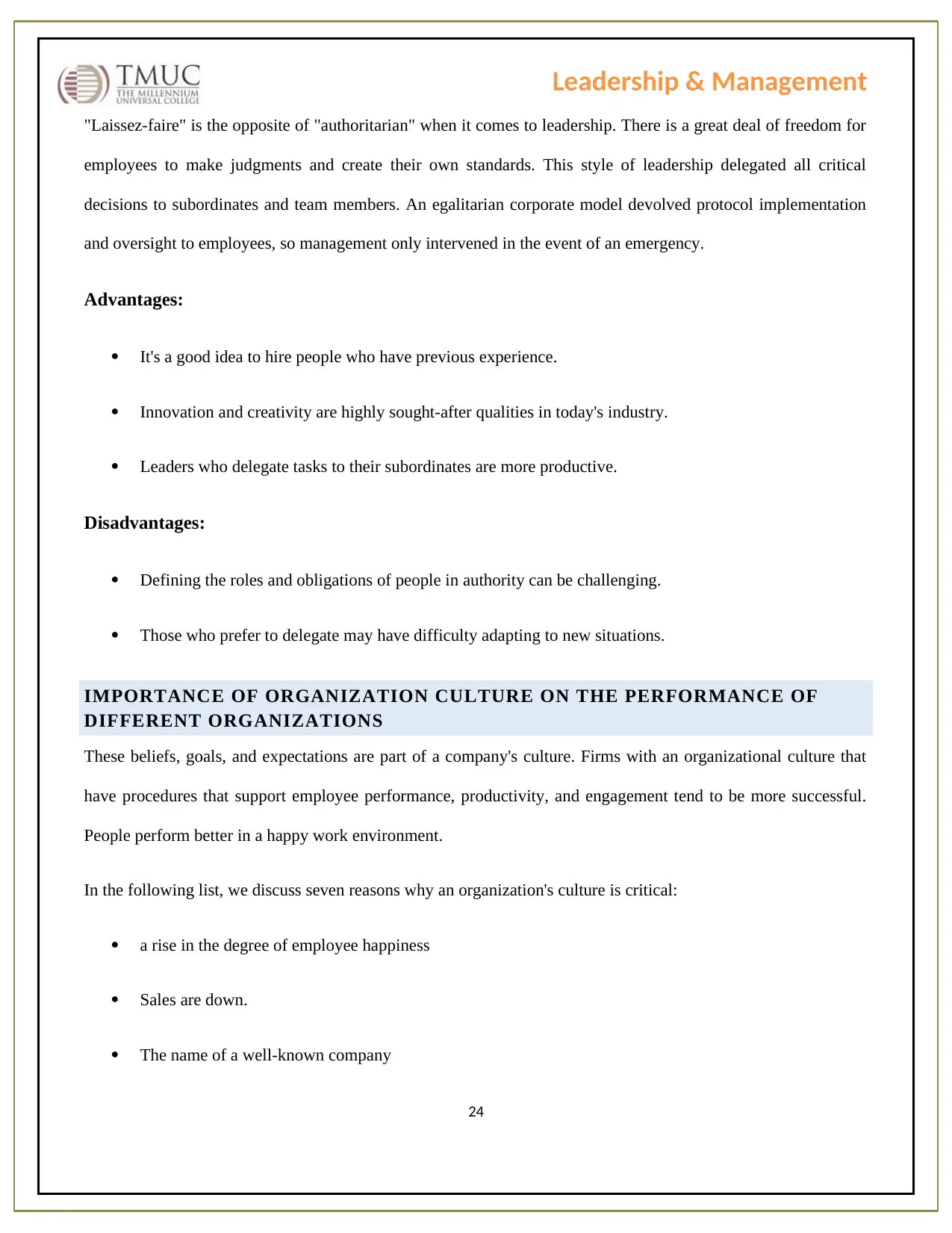
Leadership & Management
"Laissez-faire" is the opposite of "authoritarian" when it comes to leadership. There is a great deal of freedom for
employees to make judgments and create their own standards. This style of leadership delegated all critical
decisions to subordinates and team members. An egalitarian corporate model devolved protocol implementation
and oversight to employees, so management only intervened in the event of an emergency.
Advantages:
It's a good idea to hire people who have previous experience.
Innovation and creativity are highly sought-after qualities in today's industry.
Leaders who delegate tasks to their subordinates are more productive.
Disadvantages:
Defining the roles and obligations of people in authority can be challenging.
Those who prefer to delegate may have difficulty adapting to new situations.
IMPORTANCE OF ORGANIZATION CULTURE ON THE PERFORMANCE OF
DIFFERENT ORGANIZATIONS
These beliefs, goals, and expectations are part of a company's culture. Firms with an organizational culture that
have procedures that support employee performance, productivity, and engagement tend to be more successful.
People perform better in a happy work environment.
In the following list, we discuss seven reasons why an organization's culture is critical:
a rise in the degree of employee happiness
Sales are down.
The name of a well-known company
24
"Laissez-faire" is the opposite of "authoritarian" when it comes to leadership. There is a great deal of freedom for
employees to make judgments and create their own standards. This style of leadership delegated all critical
decisions to subordinates and team members. An egalitarian corporate model devolved protocol implementation
and oversight to employees, so management only intervened in the event of an emergency.
Advantages:
It's a good idea to hire people who have previous experience.
Innovation and creativity are highly sought-after qualities in today's industry.
Leaders who delegate tasks to their subordinates are more productive.
Disadvantages:
Defining the roles and obligations of people in authority can be challenging.
Those who prefer to delegate may have difficulty adapting to new situations.
IMPORTANCE OF ORGANIZATION CULTURE ON THE PERFORMANCE OF
DIFFERENT ORGANIZATIONS
These beliefs, goals, and expectations are part of a company's culture. Firms with an organizational culture that
have procedures that support employee performance, productivity, and engagement tend to be more successful.
People perform better in a happy work environment.
In the following list, we discuss seven reasons why an organization's culture is critical:
a rise in the degree of employee happiness
Sales are down.
The name of a well-known company
24
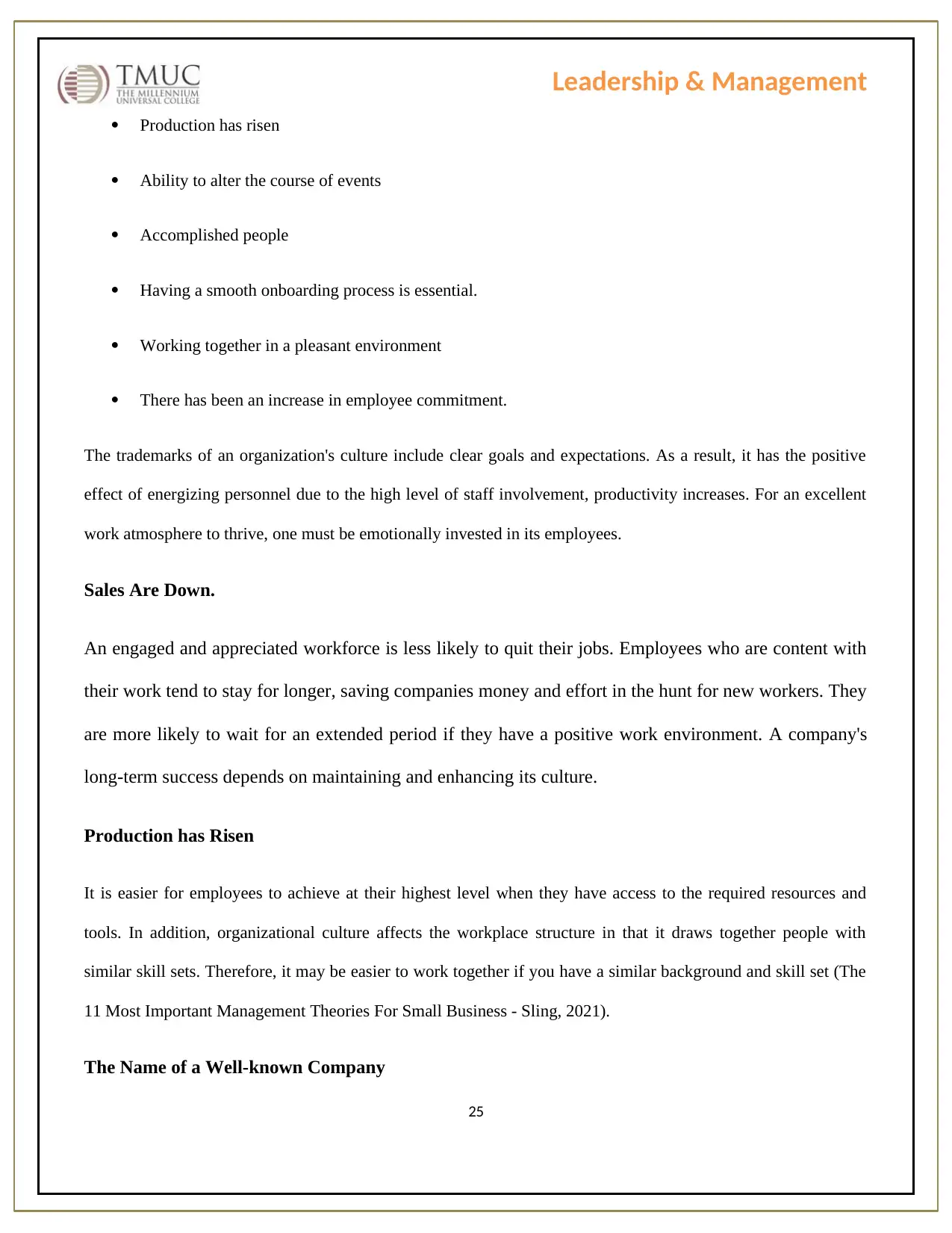
Leadership & Management
Production has risen
Ability to alter the course of events
Accomplished people
Having a smooth onboarding process is essential.
Working together in a pleasant environment
There has been an increase in employee commitment.
The trademarks of an organization's culture include clear goals and expectations. As a result, it has the positive
effect of energizing personnel due to the high level of staff involvement, productivity increases. For an excellent
work atmosphere to thrive, one must be emotionally invested in its employees.
Sales Are Down.
An engaged and appreciated workforce is less likely to quit their jobs. Employees who are content with
their work tend to stay for longer, saving companies money and effort in the hunt for new workers. They
are more likely to wait for an extended period if they have a positive work environment. A company's
long-term success depends on maintaining and enhancing its culture.
Production has Risen
It is easier for employees to achieve at their highest level when they have access to the required resources and
tools. In addition, organizational culture affects the workplace structure in that it draws together people with
similar skill sets. Therefore, it may be easier to work together if you have a similar background and skill set (The
11 Most Important Management Theories For Small Business - Sling, 2021).
The Name of a Well-known Company
25
Production has risen
Ability to alter the course of events
Accomplished people
Having a smooth onboarding process is essential.
Working together in a pleasant environment
There has been an increase in employee commitment.
The trademarks of an organization's culture include clear goals and expectations. As a result, it has the positive
effect of energizing personnel due to the high level of staff involvement, productivity increases. For an excellent
work atmosphere to thrive, one must be emotionally invested in its employees.
Sales Are Down.
An engaged and appreciated workforce is less likely to quit their jobs. Employees who are content with
their work tend to stay for longer, saving companies money and effort in the hunt for new workers. They
are more likely to wait for an extended period if they have a positive work environment. A company's
long-term success depends on maintaining and enhancing its culture.
Production has Risen
It is easier for employees to achieve at their highest level when they have access to the required resources and
tools. In addition, organizational culture affects the workplace structure in that it draws together people with
similar skill sets. Therefore, it may be easier to work together if you have a similar background and skill set (The
11 Most Important Management Theories For Small Business - Sling, 2021).
The Name of a Well-known Company
25
Paraphrase This Document
Need a fresh take? Get an instant paraphrase of this document with our AI Paraphraser
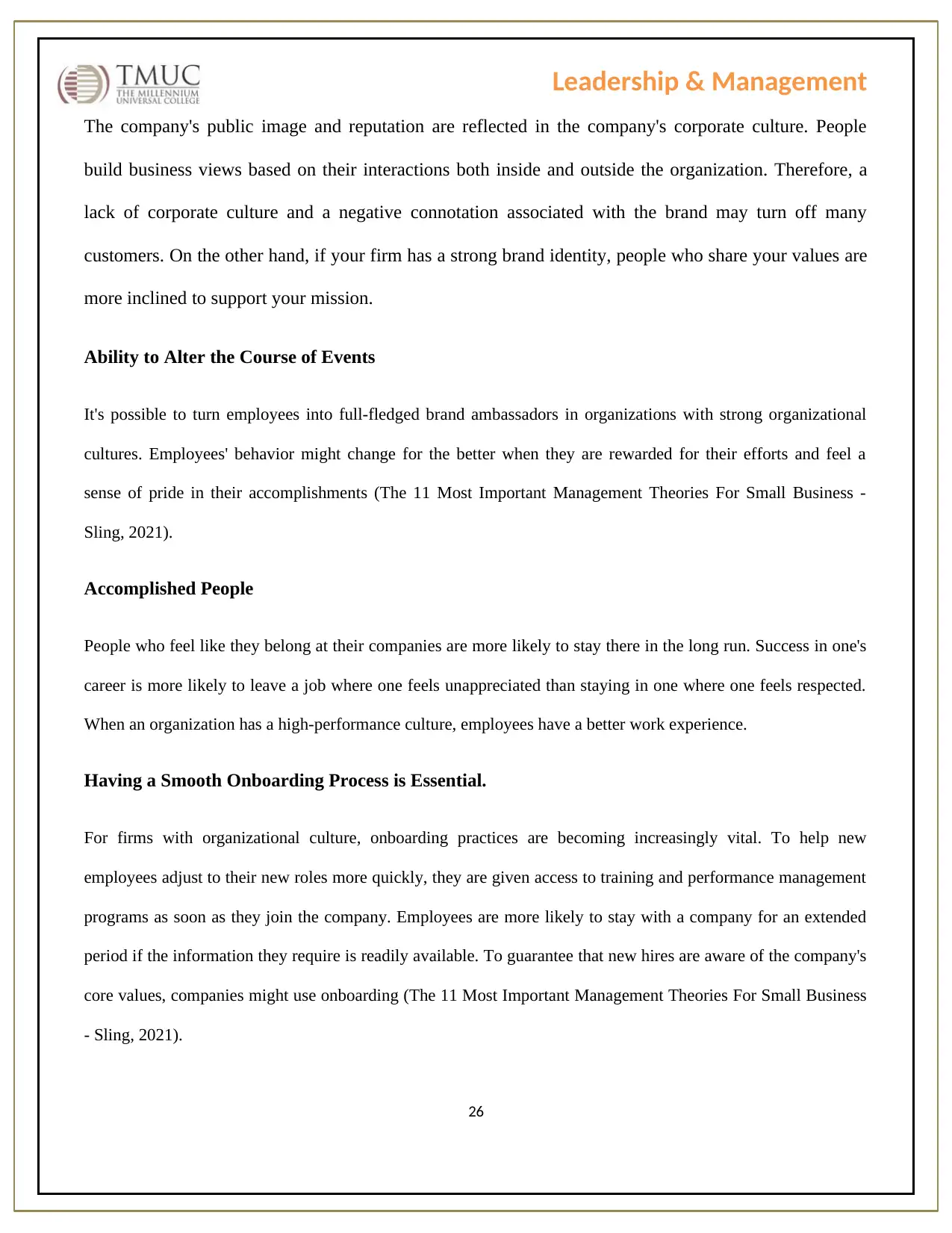
Leadership & Management
The company's public image and reputation are reflected in the company's corporate culture. People
build business views based on their interactions both inside and outside the organization. Therefore, a
lack of corporate culture and a negative connotation associated with the brand may turn off many
customers. On the other hand, if your firm has a strong brand identity, people who share your values are
more inclined to support your mission.
Ability to Alter the Course of Events
It's possible to turn employees into full-fledged brand ambassadors in organizations with strong organizational
cultures. Employees' behavior might change for the better when they are rewarded for their efforts and feel a
sense of pride in their accomplishments (The 11 Most Important Management Theories For Small Business -
Sling, 2021).
Accomplished People
People who feel like they belong at their companies are more likely to stay there in the long run. Success in one's
career is more likely to leave a job where one feels unappreciated than staying in one where one feels respected.
When an organization has a high-performance culture, employees have a better work experience.
Having a Smooth Onboarding Process is Essential.
For firms with organizational culture, onboarding practices are becoming increasingly vital. To help new
employees adjust to their new roles more quickly, they are given access to training and performance management
programs as soon as they join the company. Employees are more likely to stay with a company for an extended
period if the information they require is readily available. To guarantee that new hires are aware of the company's
core values, companies might use onboarding (The 11 Most Important Management Theories For Small Business
- Sling, 2021).
26
The company's public image and reputation are reflected in the company's corporate culture. People
build business views based on their interactions both inside and outside the organization. Therefore, a
lack of corporate culture and a negative connotation associated with the brand may turn off many
customers. On the other hand, if your firm has a strong brand identity, people who share your values are
more inclined to support your mission.
Ability to Alter the Course of Events
It's possible to turn employees into full-fledged brand ambassadors in organizations with strong organizational
cultures. Employees' behavior might change for the better when they are rewarded for their efforts and feel a
sense of pride in their accomplishments (The 11 Most Important Management Theories For Small Business -
Sling, 2021).
Accomplished People
People who feel like they belong at their companies are more likely to stay there in the long run. Success in one's
career is more likely to leave a job where one feels unappreciated than staying in one where one feels respected.
When an organization has a high-performance culture, employees have a better work experience.
Having a Smooth Onboarding Process is Essential.
For firms with organizational culture, onboarding practices are becoming increasingly vital. To help new
employees adjust to their new roles more quickly, they are given access to training and performance management
programs as soon as they join the company. Employees are more likely to stay with a company for an extended
period if the information they require is readily available. To guarantee that new hires are aware of the company's
core values, companies might use onboarding (The 11 Most Important Management Theories For Small Business
- Sling, 2021).
26
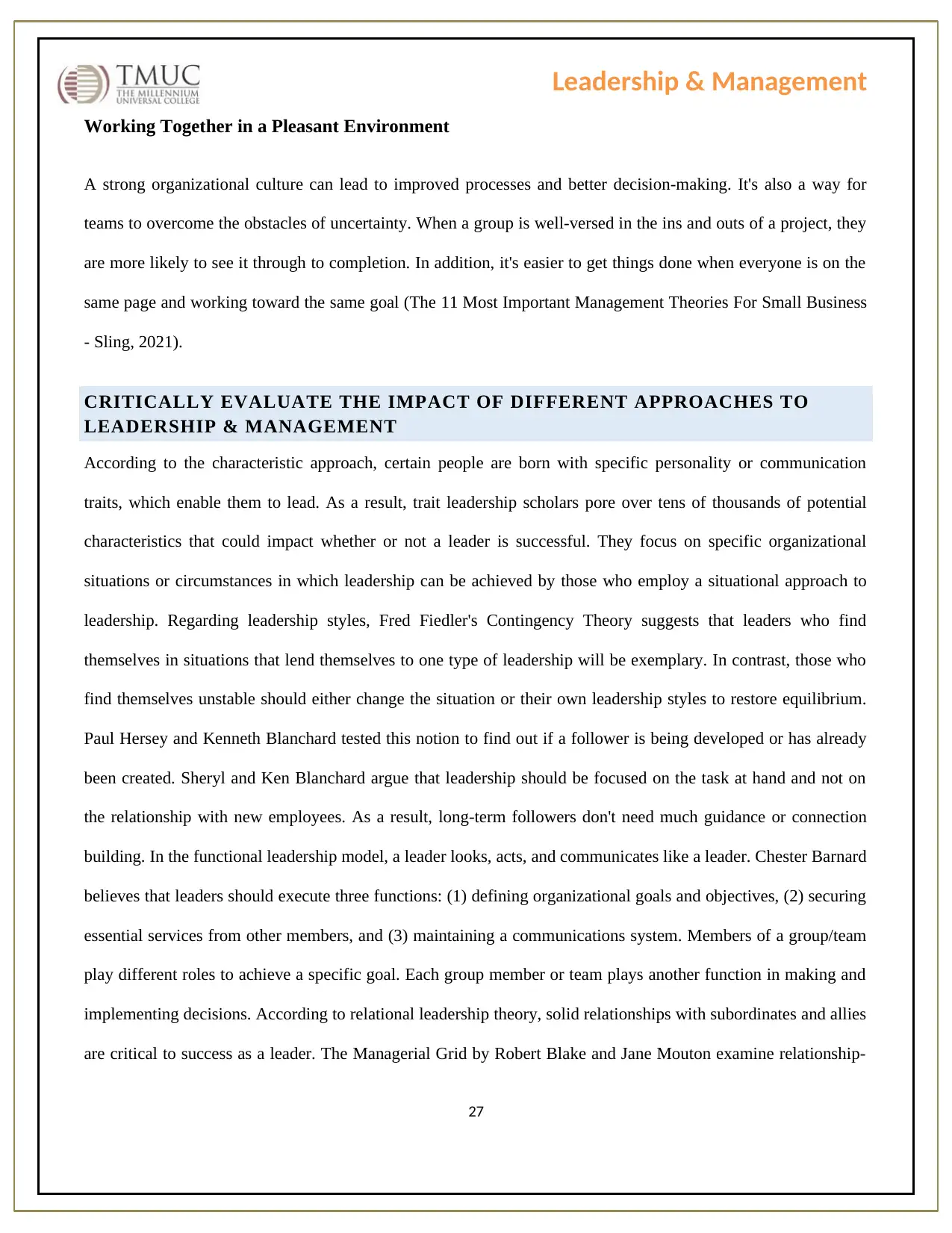
Leadership & Management
Working Together in a Pleasant Environment
A strong organizational culture can lead to improved processes and better decision-making. It's also a way for
teams to overcome the obstacles of uncertainty. When a group is well-versed in the ins and outs of a project, they
are more likely to see it through to completion. In addition, it's easier to get things done when everyone is on the
same page and working toward the same goal (The 11 Most Important Management Theories For Small Business
- Sling, 2021).
CRITICALLY EVALUATE THE IMPACT OF DIFFERENT APPROACHES TO
LEADERSHIP & MANAGEMENT
According to the characteristic approach, certain people are born with specific personality or communication
traits, which enable them to lead. As a result, trait leadership scholars pore over tens of thousands of potential
characteristics that could impact whether or not a leader is successful. They focus on specific organizational
situations or circumstances in which leadership can be achieved by those who employ a situational approach to
leadership. Regarding leadership styles, Fred Fiedler's Contingency Theory suggests that leaders who find
themselves in situations that lend themselves to one type of leadership will be exemplary. In contrast, those who
find themselves unstable should either change the situation or their own leadership styles to restore equilibrium.
Paul Hersey and Kenneth Blanchard tested this notion to find out if a follower is being developed or has already
been created. Sheryl and Ken Blanchard argue that leadership should be focused on the task at hand and not on
the relationship with new employees. As a result, long-term followers don't need much guidance or connection
building. In the functional leadership model, a leader looks, acts, and communicates like a leader. Chester Barnard
believes that leaders should execute three functions: (1) defining organizational goals and objectives, (2) securing
essential services from other members, and (3) maintaining a communications system. Members of a group/team
play different roles to achieve a specific goal. Each group member or team plays another function in making and
implementing decisions. According to relational leadership theory, solid relationships with subordinates and allies
are critical to success as a leader. The Managerial Grid by Robert Blake and Jane Mouton examine relationship-
27
Working Together in a Pleasant Environment
A strong organizational culture can lead to improved processes and better decision-making. It's also a way for
teams to overcome the obstacles of uncertainty. When a group is well-versed in the ins and outs of a project, they
are more likely to see it through to completion. In addition, it's easier to get things done when everyone is on the
same page and working toward the same goal (The 11 Most Important Management Theories For Small Business
- Sling, 2021).
CRITICALLY EVALUATE THE IMPACT OF DIFFERENT APPROACHES TO
LEADERSHIP & MANAGEMENT
According to the characteristic approach, certain people are born with specific personality or communication
traits, which enable them to lead. As a result, trait leadership scholars pore over tens of thousands of potential
characteristics that could impact whether or not a leader is successful. They focus on specific organizational
situations or circumstances in which leadership can be achieved by those who employ a situational approach to
leadership. Regarding leadership styles, Fred Fiedler's Contingency Theory suggests that leaders who find
themselves in situations that lend themselves to one type of leadership will be exemplary. In contrast, those who
find themselves unstable should either change the situation or their own leadership styles to restore equilibrium.
Paul Hersey and Kenneth Blanchard tested this notion to find out if a follower is being developed or has already
been created. Sheryl and Ken Blanchard argue that leadership should be focused on the task at hand and not on
the relationship with new employees. As a result, long-term followers don't need much guidance or connection
building. In the functional leadership model, a leader looks, acts, and communicates like a leader. Chester Barnard
believes that leaders should execute three functions: (1) defining organizational goals and objectives, (2) securing
essential services from other members, and (3) maintaining a communications system. Members of a group/team
play different roles to achieve a specific goal. Each group member or team plays another function in making and
implementing decisions. According to relational leadership theory, solid relationships with subordinates and allies
are critical to success as a leader. The Managerial Grid by Robert Blake and Jane Mouton examine relationship-
27
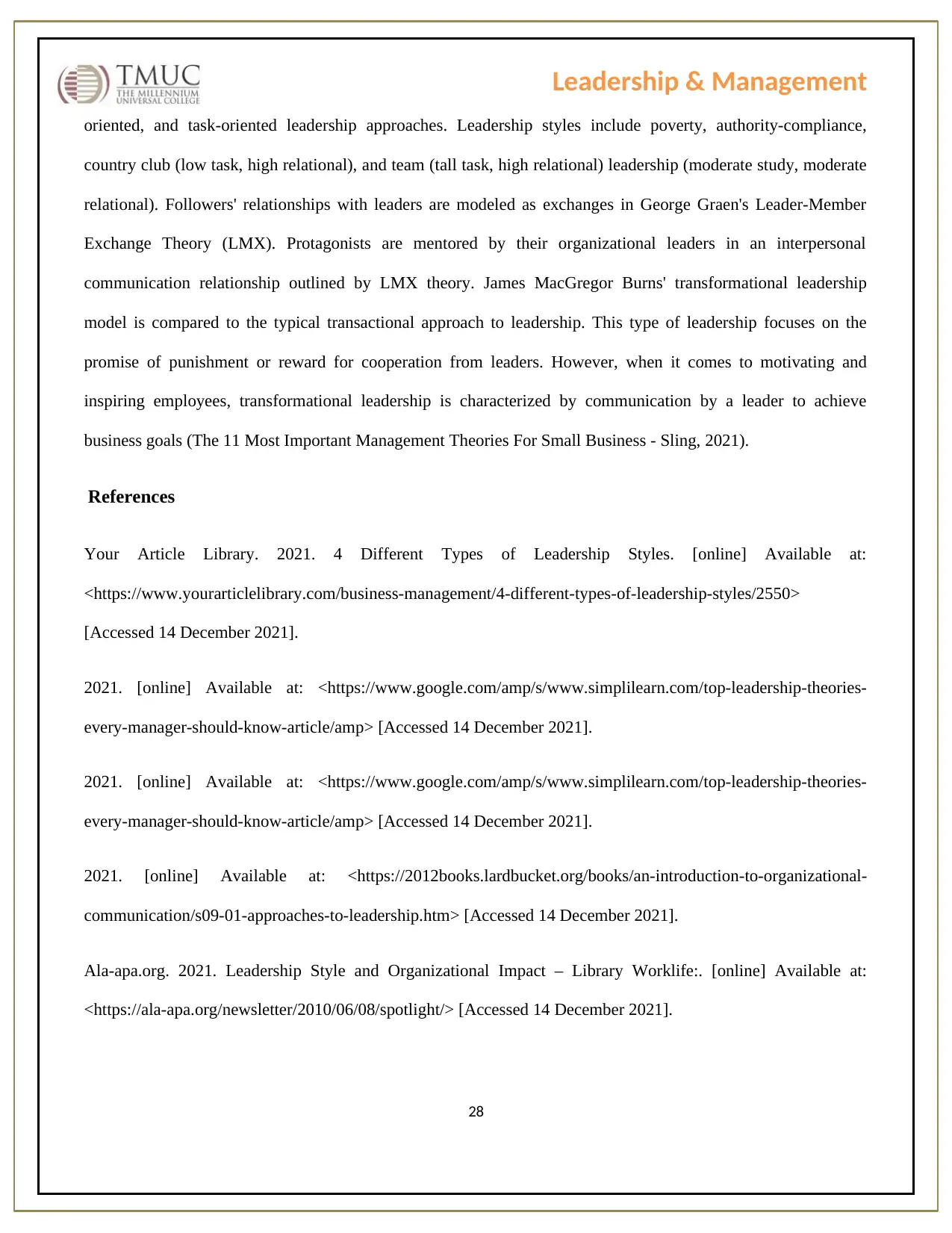
Leadership & Management
oriented, and task-oriented leadership approaches. Leadership styles include poverty, authority-compliance,
country club (low task, high relational), and team (tall task, high relational) leadership (moderate study, moderate
relational). Followers' relationships with leaders are modeled as exchanges in George Graen's Leader-Member
Exchange Theory (LMX). Protagonists are mentored by their organizational leaders in an interpersonal
communication relationship outlined by LMX theory. James MacGregor Burns' transformational leadership
model is compared to the typical transactional approach to leadership. This type of leadership focuses on the
promise of punishment or reward for cooperation from leaders. However, when it comes to motivating and
inspiring employees, transformational leadership is characterized by communication by a leader to achieve
business goals (The 11 Most Important Management Theories For Small Business - Sling, 2021).
References
Your Article Library. 2021. 4 Different Types of Leadership Styles. [online] Available at:
<https://www.yourarticlelibrary.com/business-management/4-different-types-of-leadership-styles/2550>
[Accessed 14 December 2021].
2021. [online] Available at: <https://www.google.com/amp/s/www.simplilearn.com/top-leadership-theories-
every-manager-should-know-article/amp> [Accessed 14 December 2021].
2021. [online] Available at: <https://www.google.com/amp/s/www.simplilearn.com/top-leadership-theories-
every-manager-should-know-article/amp> [Accessed 14 December 2021].
2021. [online] Available at: <https://2012books.lardbucket.org/books/an-introduction-to-organizational-
communication/s09-01-approaches-to-leadership.htm> [Accessed 14 December 2021].
Ala-apa.org. 2021. Leadership Style and Organizational Impact – Library Worklife:. [online] Available at:
<https://ala-apa.org/newsletter/2010/06/08/spotlight/> [Accessed 14 December 2021].
28
oriented, and task-oriented leadership approaches. Leadership styles include poverty, authority-compliance,
country club (low task, high relational), and team (tall task, high relational) leadership (moderate study, moderate
relational). Followers' relationships with leaders are modeled as exchanges in George Graen's Leader-Member
Exchange Theory (LMX). Protagonists are mentored by their organizational leaders in an interpersonal
communication relationship outlined by LMX theory. James MacGregor Burns' transformational leadership
model is compared to the typical transactional approach to leadership. This type of leadership focuses on the
promise of punishment or reward for cooperation from leaders. However, when it comes to motivating and
inspiring employees, transformational leadership is characterized by communication by a leader to achieve
business goals (The 11 Most Important Management Theories For Small Business - Sling, 2021).
References
Your Article Library. 2021. 4 Different Types of Leadership Styles. [online] Available at:
<https://www.yourarticlelibrary.com/business-management/4-different-types-of-leadership-styles/2550>
[Accessed 14 December 2021].
2021. [online] Available at: <https://www.google.com/amp/s/www.simplilearn.com/top-leadership-theories-
every-manager-should-know-article/amp> [Accessed 14 December 2021].
2021. [online] Available at: <https://www.google.com/amp/s/www.simplilearn.com/top-leadership-theories-
every-manager-should-know-article/amp> [Accessed 14 December 2021].
2021. [online] Available at: <https://2012books.lardbucket.org/books/an-introduction-to-organizational-
communication/s09-01-approaches-to-leadership.htm> [Accessed 14 December 2021].
Ala-apa.org. 2021. Leadership Style and Organizational Impact – Library Worklife:. [online] Available at:
<https://ala-apa.org/newsletter/2010/06/08/spotlight/> [Accessed 14 December 2021].
28
Secure Best Marks with AI Grader
Need help grading? Try our AI Grader for instant feedback on your assignments.
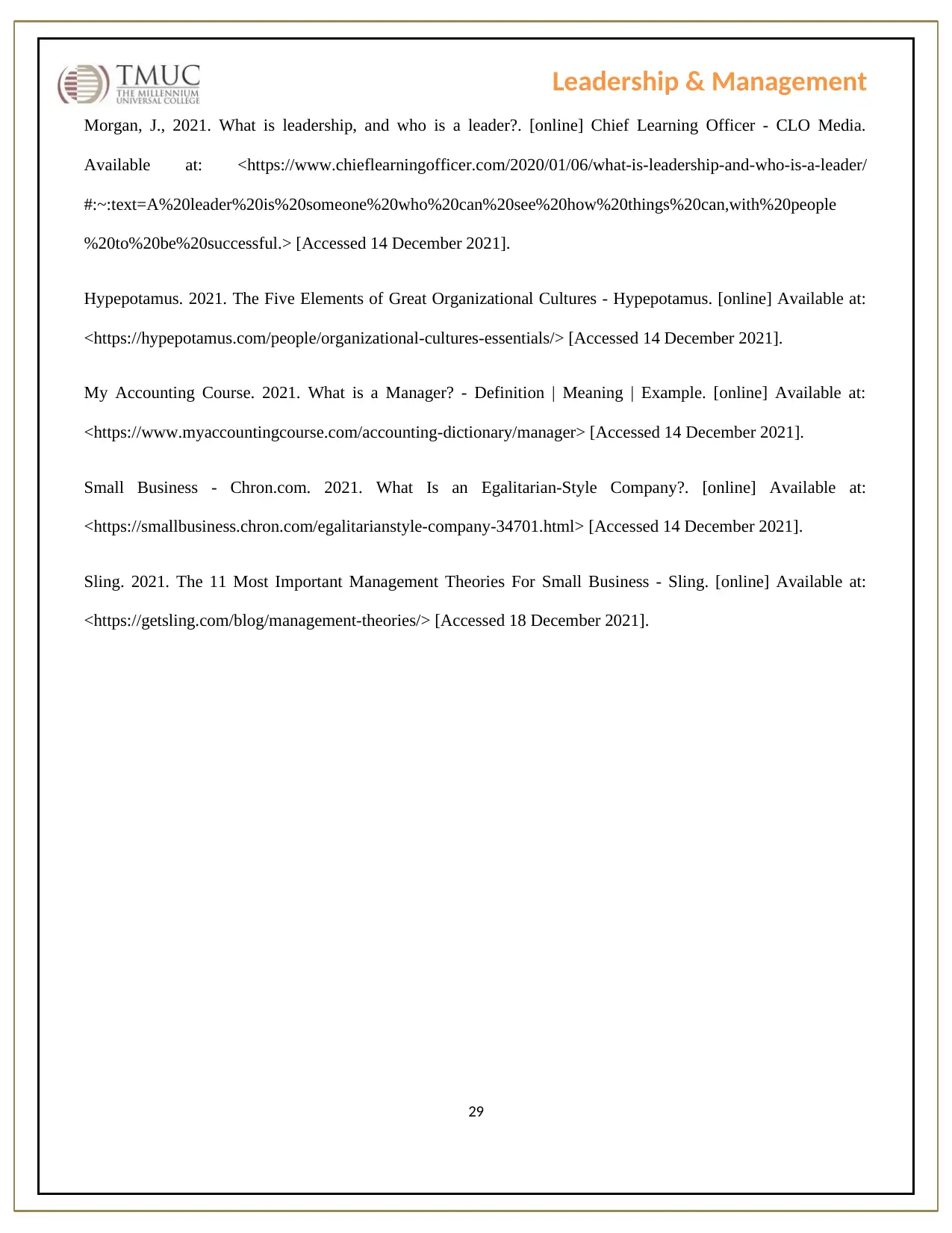
Leadership & Management
Morgan, J., 2021. What is leadership, and who is a leader?. [online] Chief Learning Officer - CLO Media.
Available at: <https://www.chieflearningofficer.com/2020/01/06/what-is-leadership-and-who-is-a-leader/
#:~:text=A%20leader%20is%20someone%20who%20can%20see%20how%20things%20can,with%20people
%20to%20be%20successful.> [Accessed 14 December 2021].
Hypepotamus. 2021. The Five Elements of Great Organizational Cultures - Hypepotamus. [online] Available at:
<https://hypepotamus.com/people/organizational-cultures-essentials/> [Accessed 14 December 2021].
My Accounting Course. 2021. What is a Manager? - Definition | Meaning | Example. [online] Available at:
<https://www.myaccountingcourse.com/accounting-dictionary/manager> [Accessed 14 December 2021].
Small Business - Chron.com. 2021. What Is an Egalitarian-Style Company?. [online] Available at:
<https://smallbusiness.chron.com/egalitarianstyle-company-34701.html> [Accessed 14 December 2021].
Sling. 2021. The 11 Most Important Management Theories For Small Business - Sling. [online] Available at:
<https://getsling.com/blog/management-theories/> [Accessed 18 December 2021].
29
Morgan, J., 2021. What is leadership, and who is a leader?. [online] Chief Learning Officer - CLO Media.
Available at: <https://www.chieflearningofficer.com/2020/01/06/what-is-leadership-and-who-is-a-leader/
#:~:text=A%20leader%20is%20someone%20who%20can%20see%20how%20things%20can,with%20people
%20to%20be%20successful.> [Accessed 14 December 2021].
Hypepotamus. 2021. The Five Elements of Great Organizational Cultures - Hypepotamus. [online] Available at:
<https://hypepotamus.com/people/organizational-cultures-essentials/> [Accessed 14 December 2021].
My Accounting Course. 2021. What is a Manager? - Definition | Meaning | Example. [online] Available at:
<https://www.myaccountingcourse.com/accounting-dictionary/manager> [Accessed 14 December 2021].
Small Business - Chron.com. 2021. What Is an Egalitarian-Style Company?. [online] Available at:
<https://smallbusiness.chron.com/egalitarianstyle-company-34701.html> [Accessed 14 December 2021].
Sling. 2021. The 11 Most Important Management Theories For Small Business - Sling. [online] Available at:
<https://getsling.com/blog/management-theories/> [Accessed 18 December 2021].
29
1 out of 29
Related Documents
Your All-in-One AI-Powered Toolkit for Academic Success.
+13062052269
info@desklib.com
Available 24*7 on WhatsApp / Email
![[object Object]](/_next/static/media/star-bottom.7253800d.svg)
Unlock your academic potential
© 2024 | Zucol Services PVT LTD | All rights reserved.





